




Nutrient-dense foods, like lean beef, contain high-quality protein , iron , zinc , choline and B-vitamins . These essential nutrients help build strong minds and strong bodies.

LEARN MORE ABOUT HOW BEEF SUPPORTS GROWTH & DEVELOPMENT
1. U.S. Department of Agriculture and U.S. Department of Health and Human Services, Dietary Guidelines for Americans, 2020-2025. 2020.
2. Schwarzenberg, S.J., M.K. Georgieff, and Committee on Nutrition, Advocacy for improving nutrition in the first 1000 days to support childhood development and adult health. Pediatrics, 2018. 141(2).
3. U.S. Department of Agriculture FoodData Central, Available at fdc.nal.usda.gov (Beef composite, cooked –NDB Number 13364). 2019.

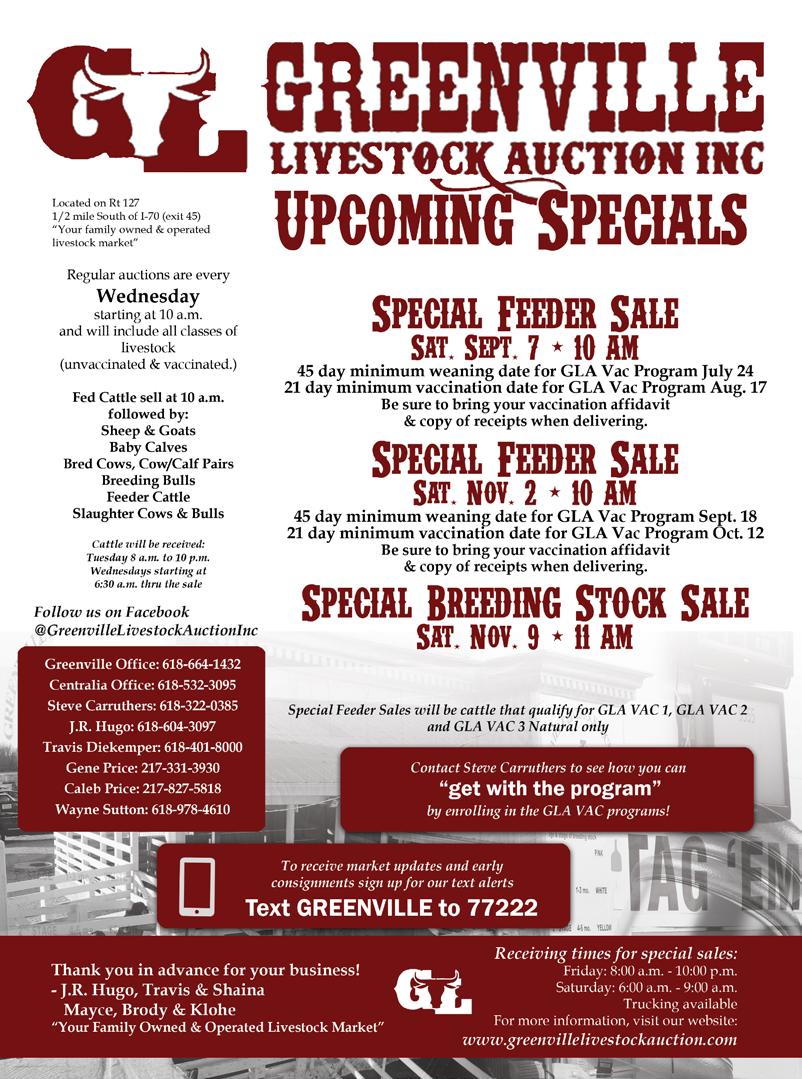



IBA hosted its Annual Meeting and Awards Ceremony on June 4, bringing together cattlemen and women, business partners and agriculture leaders from across the state. Turn here for a recap, photos and award winner shots.
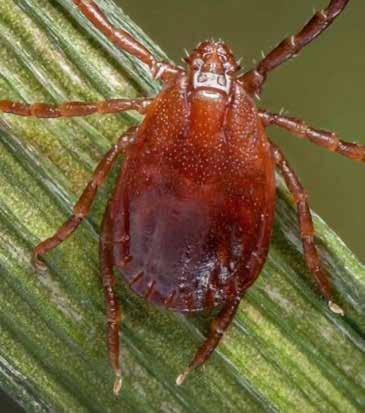

USDA has announced their final ruling on animal disease traceability to be implemented soon. Turn here to read more about the time line and what that means for you as the producer. Then, turn the page to know how to obtain a Premises ID and to have your questions answered by the IDOA Chief of Animal Health and Welfare.
With the increase in risks facing operations today, cattle producers are challenged to improve biosecurity practices to protect their animals and workers. NCBA’s Julia Herman, DVM, MS, DACVPM, shares how to do just that.
The long-anticipated Asian Longhorned Tick has now been found in Illinois. Whether you were prepared or not we have gathered information for tackling and preventing any threats the new species may pose.

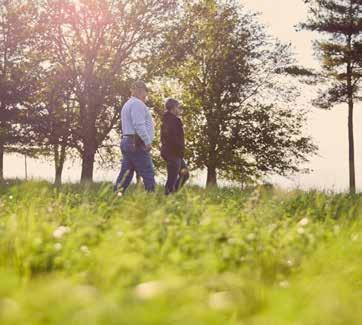
IBA Environmental Stewards of the Year, Wes and Martha Green, prove that working to preserve their farm ground has lasting benefits.
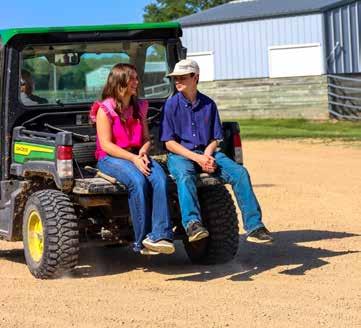
38 Kade and Kendall
Boatman twins named IBA’s 2024 Outstanding Juniors of the year, prioritize being the hardest workers in the room, staying humble and doing the right thing.

Get ready for this year’s IJBA Jackpot show during the first Sunday of the Illinois State Fair. Also in this section you will find other state fair junior activities and a recap of the recent Junior Beef Tour.


Taken at 2024 IBA Member of the Year, Justin Rahn’s farm. Photo by Devin Bollman.
Dave Duzan, Lexington President
IBA Board of Governors
Email: duzanagy@mtco.com


Directors
District 1
Justin Rahn, Mt. Carroll, justinrahn@hotmail.com
1st term expires: 2025 | 2nd term expires: 2028
District 2
Jake Perino, Deer Grove, twinrailsoverp@gmail.com
1st term expires: 2022 | 2nd term expires: 2025
District 3
Doug Hanson, Danforth, dough@proharvestseeds.com
1st term expires: 2026 | 2nd term expires: 2029
District 4
Cody Lowderman, Macomb, codylowderman@yahoo.com
1st term expires: 2024 | 2nd term expires: 2027
District 5
Joan Harrison, Minier, joan.harrison16@yahoo.com
1st term expires: 2027 | 2nd term expires: 2030
District 6
Matt Witte, Heyworth, matthewcwitte@gmail.com
1st term expires: 2022 | 2nd term expires: 2025
District 7
Kevin Rose, Salem, krr1998@hotmail.com
1st term expires: 2024 | 2nd term expires: 2027
At Large Directors
Scott Wetzell, Tampico, sd_wetz@hotmail.com
1st term expires: 2026 | 2nd term expires: 2029
Jake Fidler, Fairview, salebarn@mymctc.net
1st term expires: 2022 | 2nd term expires: 2025
Wes Hornback, Monticello,whornba2@gmail.com
1st term expires: 2024 | 2nd term expires: 2027
Bruce Betzold, Nokomis, betzoldfarms@yahoo.com
1st term expires: 2022 | 2nd term expires: 2025
Larisa Willrett, Malta, lwillrett1313@gmail.com
1st term expires: 2022 | 2nd term expires: 2025
Rick Dean, Le Roy, deanfarm4@gmail.com
1st term expires: 2024 | 2nd term expires: 2027
Ted Prehn, Jerseyville, tedprehn@gmail.com
1st term expires: 2026 | 2nd term expires: 2029
Executive Vice President Financial Officer
Programs & Services Manager
Membership & Communications Manager
Publications & Business Operations Manager
Shannon Welsh, Blandinsville Vice President
IBA Board of Governors
Email: cowdynasty@yahoo.com
Directors
District 1
Anna Flikkema, Lanark, flikkema.anna@gmail.com
1st term expires: 2025 | 2nd term expires: 2028
Lou Lamoreux, Lanark, unclelou49@gmail.com
1st term expires: 2023 | 2nd term expires: 2026
District 2
OPEN
Bill Gebeck, Buda, wgebeck@aol.com
1st term expires: 2023 | 2nd term expires: 2026
District 3
Jamie Martz, Maple Park, jamiemartz85@gmail.com
1st term expires: 2024 | 2nd term expires: 2027
Kip Harms, Cullom, harms2@frontiernet.com
1st term expires: 2026 | 2nd term expires: 2029
District 4
Carol Lock, Avon, clock7857@gmail.com
1st term expires: 2025 | 2nd term expires: 2028
Thad Tharp, Monmouth, tthaddeus88@gmail.com
1st term expires: 2023 | 2nd term expires: 2026
District 5
Betsy Pech, Lincoln, bpech55@gmail.com
1st term expires: 2027 | 2nd term expires: 2030
Darin Smith, Alexander, simmybreeder68@hotmail.com
1st term expires: 2023 | 2nd term expires: 2026
District 6
Chase Brown, Warrensburg, cdbrow2@gmail.com
1st term expires: 2022 | 2nd term expires: 2025
Wendell Alwardt, Altamont, walwardt1@yahoo.com
1st term expires: 2023 | 2nd term expires: 2026
District 7
Garrett Mattox, Anna, bigmcattle@hotmail.com
1st term expires: 2025 | 2nd term expires: 2028
Ryan DeWitt, Cobden, rdewitt93@gmail.com
1st term expires: 2026 | 2nd term expires: 2029
Josh St. Peters, josh@illinoisbeef.com
Mary Faber, accounting@illinoisbeef.com
Annie Schoetmer, annie@illinoisbeef.com
Devin Bollman, devin@illinoisbeef.com
Olivia Hoots, olivia@illinoisbeef.com
Dr. Paul Walker
Travis Meteer
Dr. Teresa Steckler
Dr. Jennifer Earing Al Lyman
Past President
U of I Extension
U of I Extension
Illinois State University
NCBA Beef Promotion Operating Committee





Dave Duzan, Illinois Beef Association President
IBA President Dave Duzan recently attended the annual United States Meat Export Federation’s spring conference, and we asked him some questions about his experience.
Can you give us an overview of the USMEF conference?
It was a two-day conference with speakers, including a very good presentation from CattleFax Executive Vice President Randy Blach. USMEF has offices throughout the world and they had their staff from all over talk about export demands in their particular countries and regions, such as popular cuts. In the U.S. our favorites are the ribeye or New York strip, but in other parts of the world they eat a lot of variety meats. In Mexico, for example, they eat tripe and tongue, which is also very popular in Japan. It was interesting to learn about the different cultural preferences for beef for people around the world, and exporting those variety meats to different countries adds to the value of the carcass.
Why do you think it was important for Illinois Beef to have a presence at this conference, and for us to maintain a relationship with USMEF as a whole?
It is important we as Illinois producers see the big picture. In the first quarter of 2024, exports added $274 to the value of a single beef carcass. That is a huge number, and we need our producers to understand the whole process, that is not only about domestic consumption and demand. It is about world consumption and demand as well.
What would you say to the producer or consumer that pushes back on the idea of meat exports?
We have to, it is part of a healthy economy. It increases our gross national product of the U.S. when we sell things overseas, increases the strength of our dollar and plays into geopolitical areas as well. We have to export beef if we want to increase the value of it domestically.
is one thing you learned that you will remember?
The main thing that jumped out to me was the value of the domestically undervalued cuts that we can sell to other countries to add value to the beef carcass. The cultural differences between countries and their beef consumption was also very interesting.

The country reports where they detailed trends, and shared how they are building demand in the country they work in.
Is there anything producers should be thinking about when it comes to the future of beef exports or just the beef industry?
We have to be a player in the world economy to make this thing work! Producers should learn what goes into marketing beef and the money that gets spent to promote our products overseas. It is such a huge effort.

Whether it is speaking with leaders on Agriculture Day or organizing junior events, the Illinois Beef Association seeks to serve its members and promote beef to consumers during the 2024 Illinois State Fair. We hope to see you there!
Wednesday, August 7
Junior Showmanship @ 1:00 p.m.
Thursday, August 8
Junior Heifers: AOB, Maine Anjou, Maintainer, Charolais, Hereford, Polled Hereford, Chianina, Limousin, Shorthorn, Shorthorn Plus, Red Angus @ 7:30 a.m.
Friday, August 9
Junior Performance Cow-Calf: AOB, Angus, Shorthorn, Simmental @ 7:30 a.m.; Junior Heifers: Simmental, Low % Simmental, Angus @ 8:00 a.m.; Supreme Champion Female Selection to follow in the Livestock Center; Open Shows: Maine Anjou and Maintainer @ 8:30 a.m., Charolais @ 11:00 a.m.
Saturday, August 10
Junior Steers @ 8:30; Grand Champion Steer Selection in Coliseum @ 4:00-6:00 p.m.; Open Shows: Polled Hereford and Hereford @ 8:00 p.m.
Sunday, August 11
Open Shows: Simmental, Limousin/Limousin Flex, Low % Simmental; Junior Steers @ 8:00 a.m.; Open Shows: Simmental, Limousin, Low % Simmental @ 8:00 a.m., Steers @ 9:00 a.m. in Junior Livestock Barn
Monday, August 12
Open Shows: Shorthorn, Shorthorn Plus, Angus
Don’t Forget to Come Visit Ribeye Corral in the Commodities Pavilion to Support the Illinois Beef Association!
August 5
Junior Stalls and Tie outs Available
August 6
Junior Breeding Females & Cow/Calf Move-In and Check-In @ 8 a.m.
August 7
Junior Steer Move-In and Check-In @ 8 a.m.
August 8 - 18
Volunteer at Ribeye Corral
August 9 - Agriculture Day!
Superior Young Producer Contest
Master Showmanship Contest @ 5:00 p.m.
August 11
IJBA Jackpot Show @ 12:00
August 14
Governor’s Sale of Champions - Coliseum of Champions
Josh St. Peters, Illinois Beef Association Executive Vice President
Earlier this year I had the opportunity to attend a national meeting of beef executives. It is a relatively small group of leaders, folks in the same kind of job as me –working for state Checkoff councils, state beef association boards and even a few national breed association leaders. We are the lucky ones, working for and on behalf of all of you. It is a privilege that we all really do celebrate when we come together as a group, and during one session at this conference we took time to go around the room and share some perspective among peers. I garnered a good laugh from the group when I shared that I wake up every morning grateful that I am not the poor SOB promoting shrimp (in an accent borrowed from Forrest Gump). But a very stoic and humbling perspective came from one of my more seasoned colleagues, an executive from a neighboring state who has spent nearly three decades leading his state cattlemen’s association. He said, “You know, the hard part of this job is the amount of time you’ll spend in line at a funeral home, when you have to pay respects and tell a good leader goodbye.” A lot of people nodded along, and I reflected on the accuracy of that statement in my own limited experience over the past three years.
A few short days later, I experienced that same challenge myself, standing in the very kind of line at a funeral home in DeKalb.
Our industry lost a tremendous friend and advocate in Jamie Willrett. The man was an exceptional presence in every room he entered, wise and kind, generous and dedicated – it did not matter if it was a beef industry board meeting, or a local 4-H fundraiser, if Jamie was in, he was all-in. Later in
this issue of the magazine you will see his obituary put together as a beautiful tribute by his family. The article recounts his leadership in our association, his impact across national organizations, his recognition with awards and accolades that mark decades of service and leadership as a cattleman, businessman and a damn good person.

Jamie holds a unique recognition as the only leader to come forward for two separate terms as the leader of IBA. He first stepped up to serve as President of the Board of Governors in 1994, and he came back when called to serve again in 1999.
But at the funeral home, standing in that line, I saw a poster put together by Jamie’s family that captured many of his catch phrases – sayings he was known for, the kind of things that uniquely celebrated his sage advice and warm sense of humor. And on that sign, quote attributed to the cattleman and leader was the phrase “the world is run by those who show up.”
Fitting words from a man who clearly practiced what he preached.
And as I mentioned, his obituary captures many of the ways he was present for us – when IBA needed a spokesman or an advocate, Jamie always showed up. But most humbling for me, as I stood there reflecting on Jamie Willrett – a former Master Farmer, Farm Family of the Year recipient, and past NCBA board member, was that Jamie’s ability to show up was perhaps most poignant in the reflections of his family, his close friends, his employees and his neighbors.

The next day at his memorial service, his daughter delivered a beautiful tribute to her dad, and she quoted him again with the words that, the world is run by those who show up. I smiled when she shared those words, thinking to myself “we hear you, Jamie.”
But Olivia also painted a vivid portrait in her remarks of a father, a friend and a businessman who was always there for the people in his life, always there to lend a hand, to help support and encourage, always there to be Jamie. It was a great celebration of a life well-lived, serving others all along the way.
A little later in the service,
a fitting eulogy was shared by Pastor Dave Bateman, a fellow cattleman and former IBA leader. In his words of faith and reflection, Dave shared scripture that celebrated the life of a farmer and faithful servant, indicative again of how Jamie showed up as a man of God, and in his daily work on the land and in the barns. Friends and family members chimed in during a time of sharing, telling stories filled with laughter and tears, in honor of his greatness.
Jamie is an inspiration; indeed, reflecting on everything he accomplished in his six decades on this Earth, I wish we all had more time with him. I will always remember a rich conversation I had with him at this past Cattle Industry Convention in Orlando, on the tradeshow floor. He was among fellow industry leaders, holding court, of sorts, discussing key policy topics that were a pressing issue at this year’s NCBA meeting. Jamie was wicked smart, and wellversed in grassroots policy, and among his peers at a meeting like that, he always shined, although he was humble and subtle in sharing his input unless it was solicited.
Our industry is ripe with great men and women. Maybe it is the legacy that is so often passed down from generation
to generation. Or maybe it is the grit and determination required when you live a vocation that is 365-days a year, dealing with cattle who have a mind of their own, and a spirit and a will unmatched by most of God’s creation. Likely, it is a little bit of all of it. Certainly, the cattle business is blessed with a lot of great people who give their all, and always seem to find a way to give a little more.
And it is in tribute to those people, like Jamie, and so many others before him, that we all should remember that sage advice: the world is run by those who show up. Not just at a meeting (although it certainly does not hurt to be present and be heard). Show up in your community, show up to those events and at church, and when the neighbor needs a helping hand. You are built for it, with experiences and insights that make the world a better place. Show up for your family – for the generation that came before you, and for the one that comes after you.
Because the celebration of your greatest virtues may well come in the hour when you are no longer here to receive it, but the impact is impeccable, just the same.

Travis Meteer, University of Illinois Extension Beef Specialist
Careful consideration in selecting replacement heifers is vital to the future of a beef herd. Each producer will have different priorities depending on herd goals. However, these selection tips will help you incorporate proven selection strategies into your process.
While there may be different selection criteria priorities on your farm, consider removing these characteristics for improving the profitability and longevity of your cowherd.
• Remove heifers born late in the calving season.
ο These heifers will be younger at breeding, calving, etc., less sexually mature, lighter in weight, and from cows starting to slip back in the breeding season
• Remove heifers that are nervous or have an attitude problem
ο There is no place for cattle that are a liability to the crew. Maternal instinct is valuable, but flighty cattle will always be a hassle and liability.
• Remove heifers that are born to cows that have calving difficulty, poor udder quality, poor feet and hoof structure, or are preg-checked open
ο Culling these problems from your herd will save you valuable time and money from future problems. It also builds more reputation and function into your herd.
• Remove heifers that are poor doers or are exceptionally small
ο These heifers will struggle to reach 65% of mature weight at breeding
• Remove heifers that are inferior phenotypically or genetically
ο Genomic testing may change your replacement pen. Identifying cattle that are genetically superior is easier now more than ever. Pulling cattle from the replacement pen that do not fit your market is wise.
• Remove heifers that are freemartins or have small pelvic scores
ο Obviously, freemartin heifers are very unlikely to breed and are not fit for saving for replacement stock. Small pelvic area is directly correlated to dystocia and calving problems. Dystocia usually results in poor breed-back. Other Consideration: Selecting replacement heifers from older cows in the herd will result in selecting cattle that are best fit for your management. These heifers are more likely to offer more longevity in your herd. Some commercial cattlemen save all female progeny and allow a synched A.I. or a very short breeding season to do the culling. Remember, there are numerous criteria for selecting replacements, make sure you are selecting cattle that will offer the most value to your herd and best fit your market.
Proper heifer development hinges on achieving a desired weight before breeding. Yet, not over-developing heifers to the point they are not prepared to live on pasture and forage-based diets for the remainder of their life.

Most literature shows heifers should be developed to 65% of mature body weight, although some have had success at slightly lower percentages. For example, consider the following scenario. Heifer Ranch maintains mature cows that weigh 1400 lbs., they calve on March 1st and their cows wean 45% of their body weight. This results in heifer calves that weigh 630 lbs. at weaning. If they are bred to calve on March 1st at two years of age, then the replacement female needs to be fed at a programmed gain of 1.04 ADG to weigh 910 at breeding. These numbers are surprising to some, but the truth is heifers developed on a steady gain do not need high energy feeds. Develop a least-cost ration, account for “profit robbers” (mud, cold, etc.) and target 65% of mature weight.
It is important for gain patterns to be steady. Many times, I see heifers that are pushed early with creep feeds and subsequent grain until steer calves are sold. Then the heifers are forgotten. However, cattle that are losing weight have poor conception rates. It is important not to burn out heifers and then crash them … all the while expecting them to breed because they are heavy enough. In fact, heifers gaining weight during breeding are far more successful at conceiving.
Some producers that are limit-feeding a heifer development ration should consider adding Rumensin to the diet. This has been shown to help heifers reach sexual maturity earlier and certainly can help them maintain adequate gains on a limit-fed ration.
• Do not under-develop heifers
• Do not over-develop heifers
• Don’t buy implanted heifers for replacements.
• Don’t implant heifers intended to be replacements.
• Manage heifers apart from bull calves, guard against heifers getting bred aside the cow
• Consult your vet on proper vaccination, be sure to administer pre-breeding vaccinations
• Always give proper mineral supplementation
• ID heifers with a tag or tattoo to allow accurate record keeping







































































































For 60 years, we’ve looked beyond the rows to help you grow more opportunities from every acre. Funded by farmers and focused on the future, we invest in promotion, advocacy, research and education to create profit opportunities and drive preference for soy from Illinois. Because together, we’re better by association.




Paul Walker, Professor Emeritus, DI Walker Consulting
For the record, I am the type of guy that believes in doing whatever it takes to get the job done correctly regardless of what it takes (within my financial means). That said, sometimes there are “work around” methods that can accomplish the same goal in an indirect manner. Biosecurity is an example. Biosecurity is a topic that has been around a long time, but one we are reading about a lot more. Biosecurity, like sustainability, can mean different things to different people. Therefore, for this article, I have chosen to use this definition — “practices designed to prevent the introduction and spread of disease between animals, and between animals and humans (to minimize disease spread).”
Developing an effective biosecurity plan for your operation can seem like an exhausting endeavor. It can include writing operation-specific biosecurity plans, contingency plans, records of animal movement, records of feed use, records of medicinal treatment, communication outlines, carcass disposal procedures, etc. The challenge in getting started is finding a balance between what is necessary and practical for your everyday activities versus the need for controlling/preventing contagious disease transmission. Accordingly, this article outlines some things a producer can do to form the outline of a biosecurity plan without requiring much time or money.
First, become Beef Quality Assurance (BQA) certified. This is easy to do, takes little time and costs no money, Every employee should be BQA certified. One can go online and access one of the BQA modules or attend one of the IBA inperson training sessions to obtain certification.
Second, secure a Premises Identification Number (PIN) for your livestock facility(s). Obtaining a PIN is easy and free. Go online to the Illinois Department of Agriculture (IDOA) website, click on PIN and enter the correct information.
Third, take a walk around your facilities from your mailbox, up the drive, around the buildings, etc. Look at your operation as though you were looking at it for the first time. Think about how your operation looks to a stranger or first-time visitor. Is it neat? Is it clean? Are the weeds growing in unused places? Are the lots clean? Is there waste feed piled around? Why are these things important in a biosecurity plan? Weeds provide a place for vectors and varmints to reside, and they can transmit disease. Waste feed and a messy feed storage/preparation area provides a home for vectors as does improper manure storage. In most cases addressing these issues requires little to no money — just some time and effort and maybe some modification in operational procedures.
Fourth, how do you handle deads? The old saying “if you have livestock, you will have dead stock” is always true. Do you have a compost facility? Do you bury deads? Do you call a rendering service? Or, do you take deads to the “back 40” for the coyotes? There is a right way and a wrong way to handle deads to prevent disease transfer. The IDOA Bureau of Animal Health and Welfare website has an informative
manual worth the read regarding the disposal of dead animals.
Fifth, do you have an information page of telephone numbers /people/ agencies, posted in an easyto-access location for all employees and family members in event of an emergency? This information page should include your veterinarian, the state veterinarian, the local law enforcement, the local road commissioner, local fire department, your farm address, your cell telephone number, your home telephone number, etc.

Sixth, review your procedure for treating sick animals, vaccinating animals and documenting treatment. A formal record keeping procedure of treatments/vaccinations can pay dividends in the event of a disease outbreak whether on your farm or on someone else’s farm. There is an old saying among scientists that “if the research is not reported in a peer reviewed journal, i.e. not documented, it was never done.” The same is true regarding vaccinations and medicinal treatments, if they are not documented (written down somewhere) how do you prove they were done?
These six procedures are easy to do, cost little-to-no money and provide the basics of a biosecurity plan. I recommend a seventh procedure that is already required for interstate shipment of breeding animals over 18 months of age, and that is begin using electronic identification (EID) ear tags. Currently “840” tags can be obtained for free from the IDOA or they can be purchased over-thecounter. Traceability is currently voluntary for most cattle. It is mandatory for breeding animals over 18 months of age that are subject to interstate transport. Traceability, just like premises registration, is an important component of any effective biosecurity program. If a producer already uses ear tags to identify cattle, including EID tags costs little more. Actually, EID tags only need to be applied to animals leaving the farm.
In the nice-to-know category, our Checkoff dollars have been funding, for many years, biosecurity initiatives and research projects designed to develop best management practices for both pre- and post- harvest biosecurity. The projects include the BQA original program and module updates. For those that are interested, these projects can be reviewed by accessing the Beef Research website at beefresearch.org and clicking the Beef Safety tab. Our producer-led national Checkoff has been proactive in developing BPM that maintain safe beef production but that are practical at the same time. Biosecurity (that includes traceability and premises registration) is here to stay. Those operations that endorse the concept will be around a long time. Those that do not will wonder what happened.
Have a great day. Doc

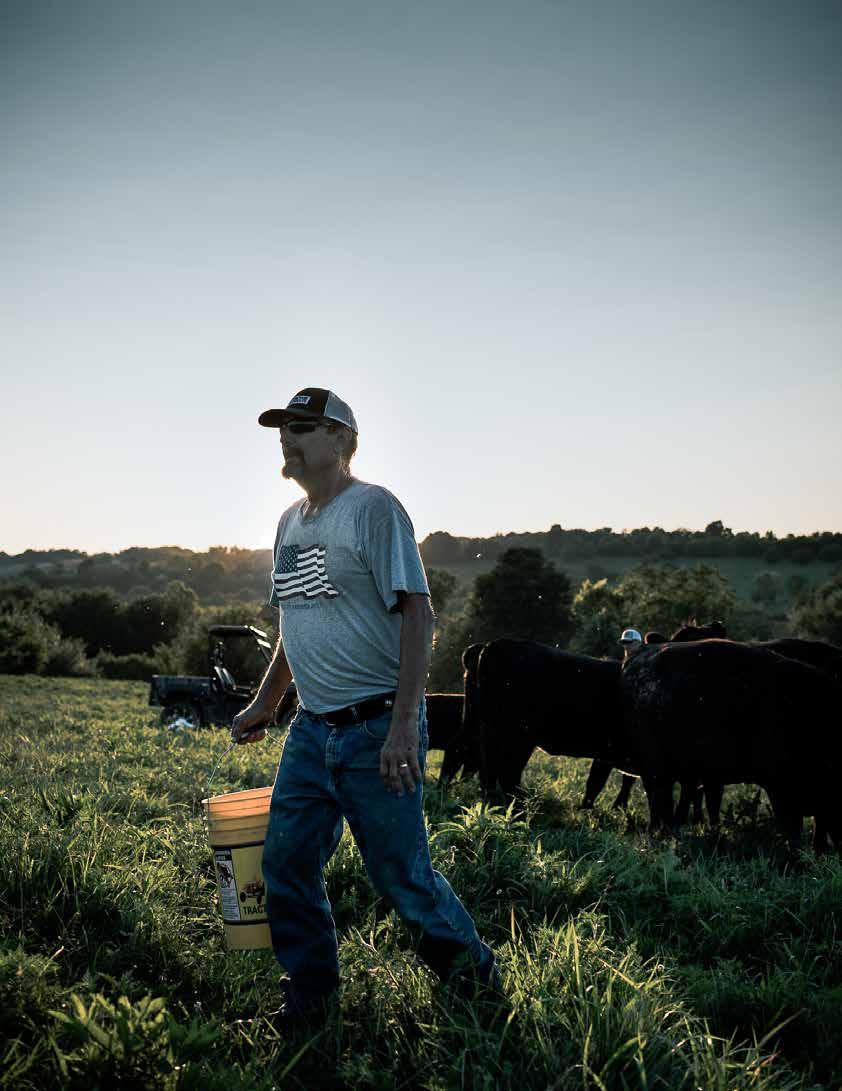
Getting things done takes sweat. Getting it done right, takes pride. BQA is proud to launch all-new online certification modules. It’s on-demand training to help you stand tall against everyday challenges. Get after it at BQA .org. Funded by the Beef Checkoff.
Tri-County Cattlemen’s Association ran a series of six “Responsibly Raised” beef billboards across Henderson, McDonough and Warren counties in celebration of May Beef Month.
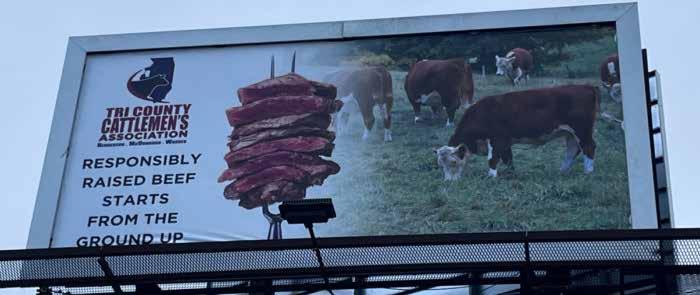
Heartland Beef Association members were guests radio station 96.3. In celebration of May Beef Month, Joan Harrison and Cori Malone spoke on the beef industry in general, and Josiah Klokkenga and Dan Haynes spoke on their involvement with the Illinois Beef Leadership Academy.

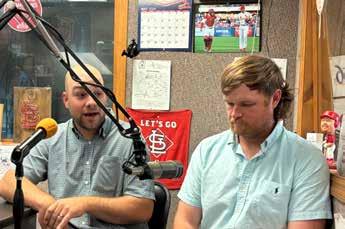
Submitting Affiliate News
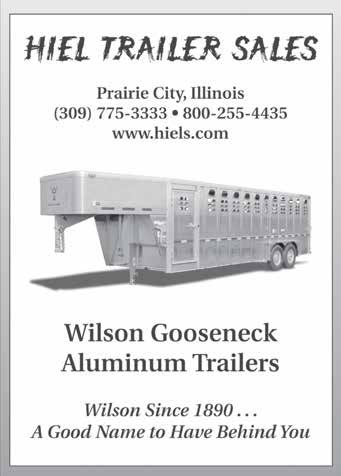
Do you have Affiliate News? Submit information to Annie Schoetmer at annie@illinoisbeef.com or call 217-787-4280. Please notify Annie with changes to affiliate officer teams.





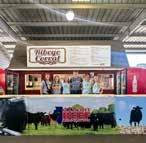
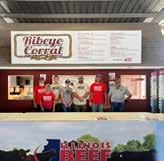
The second Beef Leadership Academy cohort wrapped up their year in Springfield. Participants discovered the relationship between IBA, IDOA, and IDNR in educational sessions and networking opportunities. Leaders and experts from each organization shared how they interact with the Association and answered participant questions on current issues within the livestock industry. Panelists and speakers included IDOA Deputy Director Kristi Jones and Chief of Staff Jeremy Flynn, Dr. John O’Keefe, Bureau Chief Animal Health and Welfare Dr. Staci Slager and Dr. Michael Arnold, veterinarian at the Illinois Department of Agriculture. The group then took a trip to the Illinois State Capitol where they got an inside look into the legislative work IBA does, and each participant met with their respective Senator and Representative in personal meetings.








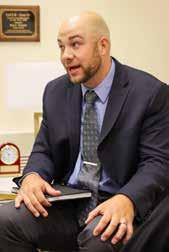



The American International Charolais Association announced recently that the Association’s Board of Directors has appointed Brett Spader as Executive Vice President, effective May 12th. Most recently Spader served as Co-Founder and CEO of Livestock Launch, a digital and data agency serving the beef and ag industry.
With over 20 years of experience in association management, technology, marketing, and business development, Spader brings a wealth of experience and a dynamic leadership style to the AICA.
“The board believes Brett is the ideal Executive Vice President to lead AICA’s next chapter of growth and success,” said Michael Sturgess, Chairman of AICA’s Board. “We have been impressed with his strong track record of innovation, execution, and developing teams and strategies that drive results.”
Marked by a commitment to effective communication, strategic planning, and fostering high-performance teams, his extensive background includes leading innovative ventures, driving significant business growth, and developing cuttingedge technologies tailored to the agricultural industry. As the founder and CEO of Livestock Launch, Spader successfully created a digital marketing business uniquely focused on the beef industry, showcasing his entrepreneurial vision and adeptness at integrating technology and communication strategies.

Kansas City, Missouri – The American International Charolais Association (AICA) announced recently that the Association’s Board of Directors has appointed Brett
Spader’s diverse experience also includes serving as Executive Director of the National Center for Beef Excellence, where he launched a non-profit business tailored to providing software and on-demand staffing resources to 6 breed associations. Further experience as President of Angus Media, Director of Operations at DVAuction, and positions with the Kansas Livestock Association generated experience in implementing new technologies and strategies for growth, marketing and member engagement.
His commitment to data-driven decision-making, industry trend analysis, and adaptive problem-solving aligns perfectly with the AICA’s goals of advancing the Charolais breed and supporting its members.
“I am honored to join AICA in this leadership role, and am grateful for the opportunity to work with staff and membership to continue to advance the Charolais breed,” said Spader. “In my previous experience with the Organization, I developed a deep appreciation for what makes AICA so special. Charolais’s success has always been anchored in creating genetics that serve all phases of the beef industry. I believe this organization and the breed it serves have tremendous opportunities as we move into the future of the beef production industry.”
IBA staff spent two days speaking to Illinois FFA students and teachers about the value of beef and understanding beef production. Students received free handouts of IJBA playing cards and our NEW Beef. It’s What’s for Dinner. branded “Eat Beef” cow ears. Teachers also received a Beef. It’s What’s for Teachers. bag packed with beef lesson teaching materials they can use for classroom engagement. The two days proved to be a massive success!






Drew Mickey was selected as the State FFA Proficiency Winner in Beef Production – Entrepreneurship. Drew is the son of Jon and Carla Mickey. He is a member of the Taylorville FFA Chapter, advised by Megan Beckmier, Charley Dammerman, and Sue Schafer. For his Supervised Agricultural Experience (SAE), Drew has cattle books in replacement beef and breeding. He raises performance Angus cattle and markets bulls to commercial producers across the Midwest while retaining replacement females for his breeding book. His responsibilities include fixing fences, maintaining pastures, marketing cattle, and performing daily chores such as feeding and cleaning pens. Drew has a strong passion for raising Angus cattle, and his SAE has expanded his knowledge of the beef industry and cattle production standards. The beef production entrepreneurship proficiency award is sponsored by the Illinois Beef Association.
Grace Lemenager was selected as the State FFA Proficiency Winner in Beef Production – Placement. Grace is the daughter of Chuck and Tori Lemenager. She is a member of the Prairie Central FFA Chapter, advised by Becky Freed, Kyle Miller, Kylie Miller, and Tyson Stork. For her Supervised Agricultural Experience (SAE), Grace works for three purebred cattle operations. Lemenager Cattle is a 40-head cow/calf operation that raises and sells high-quality genetics. She maintains herd and calf health, makes nutritional decisions for the farm, and manages all other aspects involved in raising Simmental cattle. She manages the show string at Lemenager Cattle, Bertsche Cattle, and Freed Livestock. She works as the show barn manager to halter-break calves, prepare them for sales and shows, ensure animal welfare, and manage high-quality show females. She looks forward to taking the skills she has learned and using them in a future career in agricultural communications while growing her family cattle operation. The beef production placement proficiency award is sponsored by the Illinois Beef Association.


IBA members are invited to register for the upcoming Stockmanship and Stewardship workshop, at Lancaster, Wis., held in the heart of the driftless region, known for its’ rolling hills, fertile soils and abundant pastures. This will be an action-packed two days, August 28 and 29, featuring a variety of topics from cattle health and well-being to pasture management and land stewardship, complemented by low-stress cattle handling demonstrations.
Producers can engage with esteemed cattle producers who have been recognized for their land stewardship efforts at the regional and national levels as they participate in an interactive panel, offering insights into their approaches to raising beef cattle while enriching their land. Culver’s restaurant, a strong advocate of farmers, will share their perspective on how sustainability and customer preferences influence their business decisions. A tour of the nearby University of Wisconsin Lancaster Ag Research Station will showcase the work done there with a focus on soil conservation and grazing projects.

The always popular low-stress cattle handling demonstrations, led by Curt Pate and Dr. Ron Gill, will teach how using the animals’ natural instincts helps improve cattle flow and makes handling easier and safer for both humans and animals. They will demonstrate using both beef cattle and beef x dairy cross cattle, providing tactics on how to move them differently based on their different instincts and behaviors. A chute side discussion will also be included.
Extension specialists and educators from Iowa State, Illinois and Wisconsin will lead breakout sessions addressing fitness for transport, pasture management, hairy heel warts, and several other topics. The conference will conclude with a dynamic panel discussion featuring AI company representatives who share how they are selecting for sustainability. Participants who attend the full training will also receive their BQA certification (a BQA test will be offered to those interested at the completion of the program on Aug. 29.)
Pre-registration is required, by visiting the event website: www.stockmanshipandstewardship.org. The event is presented thru a partnership between NCBA, BQA, the Beef Checkoff and Neogen.

IBA leaders and beef producers across the country mourn the loss of cattleman Jamie Willrett
James “Jamie” Willrett, 63, Malta, passed away suddenly May 3, 2024, after a cancer diagnosis. Jamie was born in DeKalb, May 14, 1960, to Bev and Jim Willrett. After graduating from Malta High School, he attended the University of Illinois where he was house president of the Alpha Gama Rho fraternity chapter and graduated with a degree in agricultural economics. Jamie returned to J. Willrett Farms as the fifth generation, helping his father, Jim, and partner Don Willrett. As Jim took a step back, Jamie took over, putting his own stamp on the operation, adding cattle feeding capacity and cropland. In 1996, along with Larson Farms, Jamie and wife Larisa began a feedlot ultrasound business. After his parents’ death, Larisa and Jamie became sole partners in the operation.
To Jamie, information was the key to success, and he was always eager to learn about the industry he loved. Jamie traveled throughout the U.S. and internationally with his involvement in the Illinois Agricultural Leadership Program and the National Young Cattlemen’s Conference. Jamie’s talent, steadfast optimism and affinity for the business of feeding cattle helped J. Willrett Farms evolve into the diversified farming and cattle feeding operation it is today.
Jamie was a devoted husband and father and fiercely loyal friend. Through their involvement in the National Cattlemen’s Beef Association, Jamie met Larisa in 1993, and they were married in September 1994. Larisa and their children – Justis, Olivia and Sawyer – were everything to him, and he was always available for coaching, calm guidance and thoughtful perspective. Jamie always had time for his children, whether it was practicing and coaching sports, helping with 4-H projects or even attending the occasional horse show. He supported each of his children’s interests and, in turn, included them in his passion for agriculture. Almost from birth, Jamie involved his children in day-to-day farm operations and inspired each of his children’s unique passion for agriculture, family and community over the years. He was close with his sisters, Jacque and Jodi, who both live less than a mile away.
Although he considered farming both his work and hobby, he also greatly enjoyed coyote hunting with his Malta crew in the winters, goose and duck hunting, fishing in Canada and gardening in the summer. He was a true outdoorsman.
Always ready with a quick smile, a chuckle and a witty comeback,



he was respected by those he interacted with in his community and beyond. Like his father, Jamie saw the importance of supporting his community and serving in leadership roles. In addition to his involvement in the Malta United Methodist Church throughout his life, he was a Malta Township Board Trustee, a member of the DeKalb FFA Alumni Committee and the DeKalb County Regional School Board, and served on the Resource Bank Board until his death.
Jamie met Larisa while he was president of the Illinois Beef Association (IBA). His service to the beef industry was immeasurable. He was on an advisory board that crafted the Illinois Livestock Management Facilities Act in 1996, served on the National Cattlemen’s Beef Association (NCBA) Board, was chairman of the NCBA International Markets Committee; was CattleFax president; and most recently was serving on the U.S. CattleTrace Board. He was named a Master Farmer in 2009 and received the IBA Farm Family of the Year Award in 2022.
In every sense possible, Jamie was an honorable man.
Jamie is survived by his wife of almost 30 years, Larisa, their children – Justis (Danielle Neisendorf), Olivia and Sawyer – and his sisters Jodi (Ken) Slade and Jacque (Brian) Fucilla. He was preceded in death by his parents, Jim and Bev Willrett.



Over 200 Illinois cattlemen and women, and industry partners, gathered in Springfield on June 4 for the 2024 Illinois Beef Association Annual Meeting and Awards Ceremony.
Every year the Association gears up for its Annual Meeting & Awards Ceremony, with the goal of bringing the best opportunities forward for producer members when it comes to educational sessions, panelists and speakers. The 2024 Annual Meeting & Awards Ceremony did just that, while also recognizing those producer members who dedicate themselves to our industry and association.
Tuesday morning kicked off with a new series of 30-minute breakout sessions that featured various panels and topics for attendees to select from. Dr. James Mitchell from the University of Arkansas joined several sessions throughout the day, the first being a breakout session called “Building the Cow Herd,” where he went into depth on cattle numbers and did a conversation -focused presentation about Illinois producer’s unique position in growing cow numbers.
On the opposite side of the building, other attendees sat down with Mike Martz and Chris Flikkema to discuss the continuing challenges cattle feeders face in Illinois and chatted about feeding cattle in the finishing stage.
Panelists Dianne Handsaker of Illinois Association of Meat Processors, Dale Pfundstein of Pfundstein Farms, and Dr. John O’Keefe with the IDOA explained niche marketing of beef, specifically value-added beef production and marketing tactics.
The final breakout session covered something most producers have, or at least should have, on the forefront of their mind - estate transfer. Malcolm and Susan Head, Trevor Toland, and University of Illinois’ Kevin Books gave unique insights on their own processes of succession planning, as well as the logistical do’s and don’ts.
IBA President, Dave Duzan led the 2024 Illinois Beef Association Annual Meeting, where he and Vice President, Shannon Welsh, were both re-elected for another term in their executive board positions. Duzan reflected on the year past, sharing pride in the Association’s accomplishments and dedication to providing for the beef industry and its members. The reins were turned over to IBA’s Executive Vice President, Josh St. Peters, who gave a more in-depth look at how Illinois is building better beef and shared the Building Better Beef - FY24 Pocket Book.
The first Cattlemen’s Education Series Session of the day brought Regional USDA APHIS Veterinarian, Dr. Susie Hexum, and Bureau Chief at the Illinois Department of Agriculture, Dr. Staci Slager, together to discuss all things cattle traceability. Hexum and Slager covered new regulations regarding the 840 EID tags, as well as the Avian Influenza and the Asian Longhorned tick. This session turned into an engaging conversation between the two speakers and session attendees of all the details and questions producers
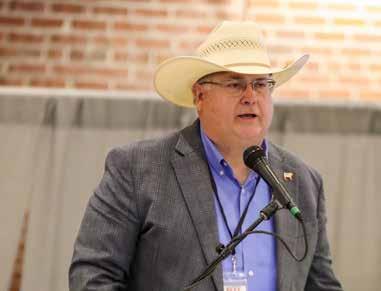
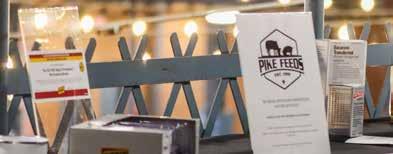

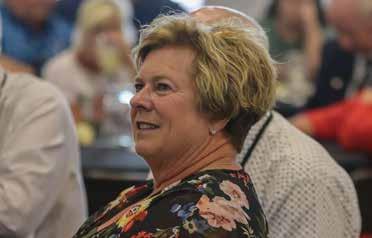




have about cattle traceability. The USDA’s final Animal Disease Traceability ruling led to an extensive conversation on producer compliance and resource availability from the Illinois Department of Agriculture.
Dr. James Mitchell rejoined the floor for the second Cattlemen’s Education Series session, presenting NCBA and CattleFax’s newly released “Right Way. Right Time. - A Guide to Cull Cattle Management.” Dr. Mitchell not only shared the publication but discussed capturing the full financial potential from cull cattle within your herd.
Rounding out the day’s Cattlemen’s Education Series sessions, was Jon Strohl from Farm Credit Illinois discussing Livestock Risk Protection. Most producers can utilize LRP within their own operations, and Jon shared how it works, why it works, and what it does for producers. He also offered insights on how to get started with LRP.
Other notable guests made appearances throughout the day. Special guest, NCBA Vice President Gene Copenhaver, gave remarks between sessions expressing the importance of producer freedoms and maintaining involvement in political advocacy for the industry. Director of the IDOA, Jerry Costello, gave remarks and talked with producers alongside his colleagues Deputy Director Kristi Jones and Chief of Staff Jeremy Flynn. Appearances also included IBA lobbyists Liz Brown-Reeves, who gave a recap of IBA political advocacy and successes at the Capitol within the last year, and her colleague, Kristin Rubbelke. Special guest, 2023-2024 Illinois FFA President, Thaddeus Bergschneider, said the evening’s blessing over the dinner.
During a brief intermission between session and the final event of the day, the IBA Awards Ceremony, the “back again” trade show hosted a reception, allowing attendees to visit with sponsors and vendors.
The day concluded with the 2024 IBA Awards Ceremony, where the Association recognized dozens of valued members and their achievements. These recognitions include the second class of Beef Leadership Academy participants graduating from the program and Illinois Beef Foundation 2024 scholarship recipients. A silent auction and raffle to raise funds for the scholarship program was held during the day’s events. IBA also recognized a “Valued Industry Partner” or “VIP,” awarded to recognize industry professionals and business partners who go above and beyond, putting their time and talents to work in support of the Association and its missions. This year the VIP award was presented to Barney Gehl of Zoetis.
Finally, IBA presented the 2024 Member Awards to the following individuals and families:
Outstanding Junior Member of the Year went to Kade & Kendall Boatman of Rockford.
IBA Member of the Year went to Justin Rahn or Mt. Carroll.
Environmental Steward of the Year went to Green’s Diamond G Farm of Atlanta.
Commercial Producer of the Year went to MAC Cattle Co. of Payson.
Seedstock Producer of the Year went to Moore Land & Cattle of Jerseyville.
Farm Family of the Year went to the Keith & Brady Kramer Family of Kramer Farms in Farina.



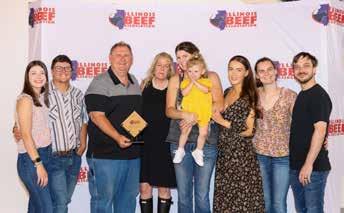




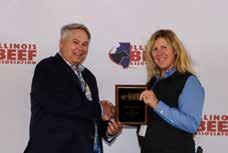

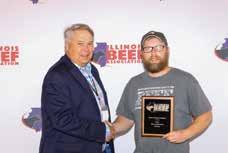

Merck donated $9,293 to the Illinois Beef Foundation for producers returning their cartridges.

Annual meeting panelists and speakers recognized and thanked with an IBA coffee mug.

Foundation scholarship recipients Audrey Curtin, Aubrey Wagner, Reese Anderson, Katelyn Engel, Lilie Perry and Ella Thacker. (Not pictured: Drew Mickey)

of
participants



Illinois County Fair Queen, Natalie Evans, also received an Illinois Beef Foundation scholarship and was recognized earlier in the day.


Illinois is the 20th state to discover the Asian longhorned tick (Haemaphysalis longicornis). The tick, considered an invasive species, was found on April 12 during routine active tick surveillance in Morgan County as part of an Illinois Department of Public Health (IDPH) grant-funded active tick surveillance program. Additional surveillance in the area on April 24 discovered two additional Asian longhorned ticks.
Identification was confirmed by entomologists at the National Veterinary Services Laboratory.
While the tick was first introduced to the U.S. in 2017, this is the first known collection of this tick species from anywhere in Illinois.
Asian longhorned ticks are light brown in color and are very small, often smaller than a sesame seed. The tick is capable of carrying tick borne diseases that affect cattle. In addition, a female can reproduce without a mate and lay up to 2,000 eggs at a time. Therefore, numbers may expand rapidly.
“In some cases of severe H. longicornis infestation, livestock death has been reported,” said Dr. Mark Ernst, Illinois Department of Agriculture (IDOA) State Veterinarian. “Farmers and producers should continue working with their veterinarian to maintain an appropriate management plan.”
The IDOA, IDPH and the Illinois Department of Natural Resources (IDNR) are monitoring the situation in partnership with the United States Department of Agriculture.
“IDPH’s active tick surveillance program was instrumental in discovering the Asian long horned tick in Illinois,” said IDPH Director Dr. Sameer Vohra. “Although the role that this tick will play in the transmission of infections in humans is yet to be determined, the Department of Public Health is working closing with the Department of Agriculture to monitor the presence of the tick and investigate the risk it carries to both humans and livestock.”
If anyone believes they have identified H. longicornis on an animal, the tick should be placed in a jar with isopropyl alcohol, and the Department of Agriculture should be contacted at 217-782-4944.
Continue reading for IDOA Tick Prevention Tips.

Use Environmental Protection Agency (EPA)registered insect repellents containing DEET, picaridin, IR3535, oil of lemon eucalyptus (OLE), para-menthane-diol (PMD) or 2-undecanone. Always follow product instructions.


Treat clothing and gear with products containing 0.5 percent permethrin. Permethrin can be used to treat boots, clothing and camping gear and remain protective through several washings. Alternatively, you can buy permethrin-treated clothing and gear.
Check your body and clothing for ticks upon return from potentially tick-infested areas, including your own backyard. Use a hand-held or full-length mirror to view all parts of your body. Place tick-infested clothes in a dryer on high heat for at least 10 minutes to kill ticks on dry clothing after you come indoors.

Shower soon after being outdoors. Showering within two hours of coming indoors has been shown to reduce your risk of getting Lyme disease and may be effective in reducing the risk of other tickborne diseases. Showering may help wash off unattached ticks and is a good time to do a tick check.
Talk to your veterinarian about tickborne diseases in your area and prevention products for your pets and livestock.
MOBILITY: The Asian Longhorned Tick is extremely mobile. It can attach to people, birds, pets, and wild animals, which spread the tick to new locations.
LONGEVITY: The tick can survive for up to a year in the environment without attaching to a host. The female tick can also reproduce without a mate, laying 1,000 to 2,000 eggs at a time. This means that if an animal picks up a single tick, it could soon be covered in thousands of ticks.
DETECTION: Because the nonengorged tick is smaller than a sesame seed, producers should inspect their livestock and use topical therapies, as needed, to control ticks.
DISEASE: The tick spreads disease and carries the blood parasite Theileria orientalis, which results in infectious bovine anemia, or Theileriosis. There is currently no approved treatment in the U.S. against Theileria orientalis, leaving cattle at risk.

The Asian Longhorned Tick is an invasive exotic pest first found in the United States in 2017. Since then, it has spread to 19 states ranging from the south (Missouri, Georgia, Tennessee) all the way up to the east coast (New York, New Jersey, Rhode Island). The tick is extremely aggressive and can cause stress and severe blood loss in cattle. The tick also carries diseases such as bovine Theileriosis, a disease that causes anemia, failure to grow (ill-thrift), persistent infection, and possible death.

By Lori Harlan, Illinois Department of Agriculture
SPRINGFIELD, IL – One of the most critical activities in an animal disease response is tracing the movement of animals. An efficient and accurate traceability system reduces the number of animals involved and response time required in a disease investigation, which in turn, reduces the economic impact on owners and affected communities.
As a result, the United States Department of Agriculture (USDA) and state animal health officials in cooperation with industry developed the Animal Disease Traceability Program to ensure official individual animal identification and premises identification traceability from farm to harvest.
On April 26, 2024, USDA Animal and Plant Health Inspection Services (APHIS) announced the final rule to increase and strengthen animal disease traceability (ADT) for certain cattle and bison.
The rule will take effect 180 days from publication in the Federal Register. The Illinois Department of Agriculture (IDOA) will provide an update with the final date, once published.
Key changes focus on the use of electronic identification (EID) as the official identification for all sexually intact cattle and bison 18 months of age and older, all dairy cattle of any age, and any cattle used for rodeo, recreation or exhibition moving interstate. This identification will be required to be read visually and electronically. Visual ear tags applied to an animal prior to the effective date of the rule will be recognized for the lifetime of that animal.
In addition, the rule will change the definition of dairy cattle to “All cattle, regardless of age or sex or current use, that are of a breed(s) or offspring of a breed used to produce milk or other dairy products for human consumption, including, but not limited to Ayrshire, Brown Swiss, Holstein, Jersey, Guernsey, Milking Shorthorn, and Red and Whites.”
To support this transition, IDOA Bureau of Animal Health and Welfare continues to offer free electronic 840 tags to cattle and bison producers and veterinarians for use in replacement cattle through an agreement with USDA. Pick up from IDOA is available during regular office hours (Monday - Friday 8 am - 4:30 pm, excluding state and federal holidays. Please note that while the tags are provided at no charge, there is a flat rate of $30 for orders that require shipping (minimum order of 100 tags, up to 500).
The Illinois Department of Agriculture requires 840 tags
for cattle and swine exhibited at the state fairs in Springfield and Du Quoin. It is the animal owner’s responsibility to ensure the necessary veterinary inspections and 840 tags in advance of arriving on the fairgrounds. A cattle or swine exhibitor arriving with an animal(s) without an 840 tag is responsible for contacting the fairgrounds veterinary provider. The provider will meet the exhibitor and assess the animal, provide a Certificate of Veterinary Inspection and install an 840 tag at the owner’s expense. Exhibitors should not rely on a veterinary provider being available on site to meet this requirement. Swine and cattle that do not have an 840 tag upon arrival and/or do not obtain a tag on site must be removed from the fairgrounds. If you have specific questions, please contact the Bureau of Animal Health and Welfare by email at agr.bahw@illinois.gov or by phone at 217782-4944.
Premises Identification involves assigning a unique number to premises involved in animal agriculture. Allied agricultural operations and non-producer participants can also be assigned Premises Identification Numbers. Information utilized to register a premises will be maintained by IDOA and is protected. During an animal health emergency, key pieces will be shared with the USDA for animal disease tracing purposes. Premises Identification is voluntary at this time and is offered at no cost to the producer.
Registering your premises is free and easy. Download and complete the Registration Form and return it to us by email, fax or mail. Once registration is complete, you will receive a premises identification number (PIN) certificate via mail or email.

Should your premises identification information change, please either fill out a new form and check “Update” at the top of the page or call 217-782-4944. If you don’t know your PIN, our team can look it up by the address or your contact information.
For questions about animal disease traceability, please contact:
Illinois Department of Agriculture - Bureau of Animal Health and Welfare
P.O. Box 19281
Springfield, Illinois 62794-9281
Telephone: (217) 782-4944
Fax: (217) 558-6033
Email: agr.premises@illinois.gov
Register your Premise today –the future of Illinois’ livestock industry is in your hands.

The Premises Identification Number Program is a database of locations where livestock are housed, raised, and produced. The free and confidential system is administered by Illinois Department of Agriculture Bureau of Animal Health & Welfare.
Each registered premise brings us one step closer to improved animal disease traceability and the ability to respond within 48 hours in the event of a disease outbreak or other animal emergencies.

Call the Illinois Department of Agriculture at 217-782-4944 or fill out the form online by visiting http://bit.ly/PremID2020 Submit your completed form by email, fax, or mail.

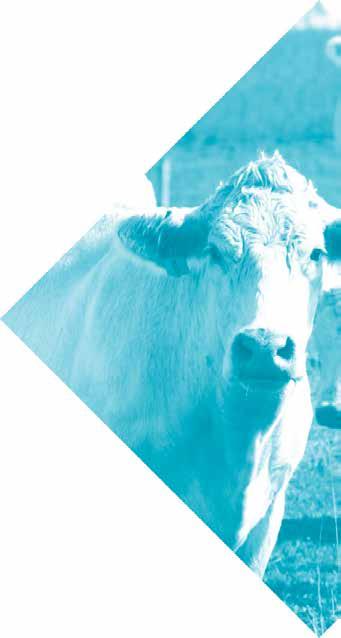



From a state department of agriculture standpoint, talk about what your team has been working on and what that means for IBA producers.
My team and I want to make sure all producers are aware and really understand what we are talking about when it comes to traceability and the various animal disease threats we are currently seeing. For producers who do not do a lot of interstate commerce, the upcoming changes are more about day-to-day events on the farm; however, those who do could potentially see a greater change in their operations (for the USDA APHIS Animal Disease Traceability Rule, see page 29). The change is that we are going from the metal NUES tags to the 840 electronic identification tags. These are currently available at our office. We have worked with USDA to make the tags available to Illinois producers so they can try them out on their operation and prep for the upcoming rule. We can provide each producer with up to 500 tags for free, minus shipping costs, if they are not picked up in-person.
We are also working on developing new informational materials so producers can better understand the upcoming rule, when it is going to take effect and what producers can do to get ahead of it.
Talk a little bit about the implementation of the rule on November 5.
We recommend every producer go ahead and register for their premises identification number (PIN) if they have not already (scan QR code on page 29). A PIN is required to order the tags, so the tags will be assigned to the PIN. This way, if there is a need to conduct a trace out, we know who the tags are registered to and can identify and reach out to the producer.
Only select staff, including myself and other staff veterinarians, have access to find where the tags have been assigned. If a tag is from another state, we do not have access to that information.
In recent months we have seen increased concern for Avian Influenza H5N1, and tick-borne illnesses based on the recent finding of the Asian Longhorned tick in Illinois. Can you walk us through why traceability matters with these issues?
Around the time the announcement came out that Influenza A (H1N1) had been found, we also got a notification from a county health department that was conducting routine tick surveillance and thought they had identified an Asian Longhorned tick, which up until this point had not been found in Illinois. It was identified as such and is considered an invasive species. Though we have not identified it in any other counties, the possibility it is in other counties is likely. This is why it is very important for producers to be aware of the situation and report any concerns to IDOA.
This tick reproduces rapidly and is also very small, which means it is essential for producers to diligently keep their eyes open for anything that could be of concern, especially with the threat of tick-borne diseases. In addition, since its detection, H5N1 has been found in dairies in 12 states. Animal disease traceability is a key component to identify any potentially exposed animals or herds.
Help us understand, as a veterinarian, what factors are considered by USDA and IDOA when deciding to start tracing beef cattle throughout the value chain?
In the event of a suspected disease outbreak, if animals have crossed state lines, we need to know what was in the area, when it was there and how to reach out to the people who were present during that time to be able to stop the movement of those animals and get the disease under control before it spreads further. We need to know who, what, when and where. Throughout the year, IDOA performs practice exercises to show our trade partners we are prepared to manage animal disease.
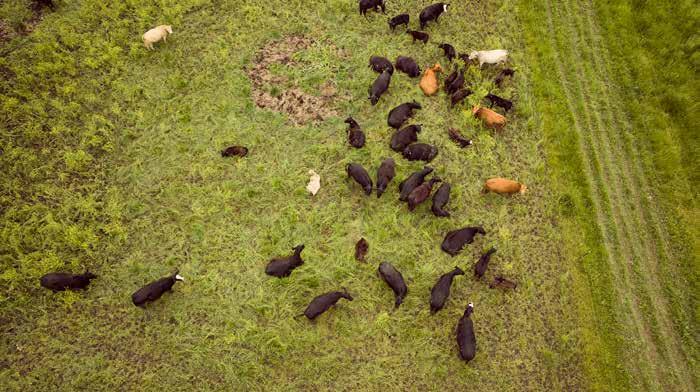
By Julia Herman, DVM, MS, DACVPM
Beef Cattle Specialist Veterinarian, NCBA, a contractor to the Beef Checkoff
Biosecurity in the cattle industry has experienced emerging challenges in recent months. Influenza A (H5N1) virus has been found in dairy herds in at least twelve states and has changed animal movement across the country. Another threat is the Asian Longhorned Tick, which has expanded its reach to beef cattle in Illinois. With all of these risks, cattle producers are challenged along with other livestock industries to improve biosecurity practices to protect their animals and workers.
As discussed in Beef Quality Assurance (BQA) program, funded by the Beef Checkoff, the goal of biosecurity is to protect animals from disease by minimizing the movement of biological organisms such as viruses, bacteria, or parasites within or onto an operation. This in turn promotes animal health and minimizes the time and labor resources required to treat a sick animal. In animal production, producers and veterinarians also should understand the importance of minimizing zoonotic disease transmission, which spreads from animals to people (or vice versa).
Daily biosecurity practices include some of the most important steps to protecting the cattle herd. BQA has partnered with the USDA funded Secure Beef Supply (SBS) Plan to develop resources for cattle producers on how to properly prepare for daily cattle diseases. The BQA Daily Biosecurity Plan for Disease Prevention template offers
an introductory, stepwise biosecurity plan for identifying biosecurity risks on cattle operations. Producers can customize plans to their own operation, allowing flexibility for producers and their resource team to evaluate what management practices work best for their situation. Working with the herd veterinarian provides unique opportunities for evaluating current practices and collaborating on steps for improvement.
This plan is a precursor to the Secure Beef Supply (SBS) Plan, an enhanced biosecurity plan which will be necessary during a potential foreign animal disease outbreak such as with foot and mouth disease (FMD). The SBS plan and training materials have more amplified biosecurity steps protecting against FMD, which is the most contagious viral disease that affects cloven-hooved animals (such as cattle, pigs, sheep, goats, and wildlife). While FMD is not a public health risk, its effects on our economy, trade, and way of life would be tremendous if this disease were to enter the U.S. or North America. On the SBS site, producers can learn more about FMD, what it looks like in affected animals, and find tools and design concepts to incorporate into their facilities and their business plans.
Content sections for both the daily and enhanced biosecurity plans are the same for consistency between plans, allowing producers and veterinarians to build up to more
stringent biosecurity steps that will be necessary for the SBS plan. As seen in Table 1, biosecurity plans are comprehensive and cover many aspects of the cattle operation. Working with your herd veterinarian to evaluate each section and discuss options should be at least an annual meeting. Some examples include:
• Training: Training for onboarding purposes or for continuing education is important to animal and human health and safety. Each operation is responsible for developing customized trainings and documenting training dates for each employee. At a minimum, understanding how biosecurity is implemented on the operation, reviewing the plan, and walking through the labeled premises map should be completed with each employee. Additional training for the operation may be required. They should be offered in the employee’s preferred language.
• Animal movement: As seen with guidance on moving dairy cattle from H5N1 diagnosed herds, animal movement records are incredibly important to trace where exposed or sick animals have traveled. Individual animal identification plays a key role in recording animal health and production parameters, in addition to disease outbreak investigation. Incoming breeding animals should be quarantined prior to entering the herd to prevent disease transmission. If unable to quarantine, such as in a feedlot, stocker, or calf raiser facility, daily observation of animals should be conducted so clinical signs of illness can be quickly identified and a veterinarian called to check. In the event of a disease outbreak and animal movement is limited, contingency plans for feed, water, and space should be in place ahead of the interrupted movement.
• Rodent control, wildlife, and other animal control: Many non-resident animals can act as a fomite and carry different diseases onto the operation. Plans for discouraging rodent or other animal movement should be discussed. Note that lethal mitigation may not be allowed for certain wildlife species, including migratory birds and endangered species, so caution should be used in choosing control measures. Protecting feed and water sources from wildlife is critical to preventing disease transmission. Discouraging nesting sites near feed and water sources is one technique. Dogs, cats, and other pets can also be fomites and should not be allowed to roam between operations.
• Labeled premises map: This aerial map of the operation, including all animal areas (dry lots, pastures, buildings, feed, manure storage, carcass disposal/pick-up) is important for training and emergency situations. A premises identification number (PIN) is a nationally unique alphanumeric code assigned by USDA to a physical location where livestock are raised, fed, or held. Producers may have a PIN already if they test for regulatory diseases like tuberculosis or brucellosis. The PIN and related info allows animal health officials to locate livestock quickly and precisely in high-risk areas due to a disaster or a contagious animal disease, like FMD. This map can also be used in the operation’s emergency action plan. A video and handouts on building a premises map or learning more about getting a PIN are available at www.bqa.org/ resources/biosecurity-resources.
1) Biosecurity manager and written biosecurity plan
2) Training
3) Protecting the cattle
4) Vehicles and equipment
5) Personnel
6) Animal movement
7) Animal products
8) Carcass disposal
Biosecurity is one thing that the producer has the most control over. Biosecurity can be adapted based on risk assessments for an operation. These aspects overlap with many aspects of the herd health plan, including nutrition, minimizing stress with good stockmanship, and vaccination programs. These topics are instrumental in employee education for guidelines to focus on every day. Identifying abnormal illness or clinical signs in cattle is important and notifying a veterinarian early in the process helps with outbreaks and treatment. All producers will start their biosecurity plans at different levels, so emphasizing foundational biosecurity principles will be advantageous during development of the plan.
Cattle producers in all sectors should strive for continuous improvement in biosecurity planning including record keeping and annual reassessment of their practices. For more information, check your BQA certification status, and downloadable preparation documents, visit the BQA website at www.bqa.org or the Secure Beef Supply Plan website at securebeef.org. The greatest contribution of the beef (and livestock) industry to disease preparedness will include proactive preparation through biosecurity planning. Collaboration among all levels of the supply chain will be vital as we continue to protect the integrity of our cattle and livestock industries.
9) Manure management
10) Rodent, wildlife, and other animal control
11) Feed and water
12) Labeled premises map
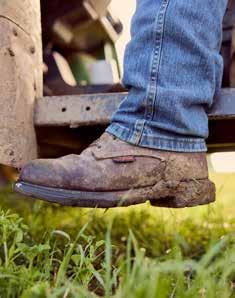
IBA Environmental Stewards of the Year, Wes and Martha Green, prove that working to preserve their farm ground has lasting benefits.
By Olivia Hoots; Photos by Zack Arnold

Grab the wire and a wrench, let’s get fencing!
Temporary fencing, reliable water sources and grass are three of the most important resources for producers who practice rotational grazing. This type of grazing is becoming more and more popular as time goes on and producers experience the benefits of it for themselves.
Wes and Martha Green of Atlanta have implemented rotational grazing and other practices into their registered Angus operation, Diamond G Farms, to maximize their resources and steward their land. These are the practices that moved their peers to nominate them for IBA Environmental Steward of the Year.
Wes still remembers his first calf at the age of eight named Sam, which he bottle-fed and showed, then sold for $365. He used his earnings to buy a registered Angus heifer from the Illinois Spotlight for $375. In 1995, when Wes’s grandfather – someone who was very influential in his life and work –passed away, he took over his 20 head of cattle, adding it to his then eight-head herd. Today, the Greens have about 60 Angus cows.
Currently, and for a long time now, they have been doing AI work for themselves and some other breeders. They first started this by crossing Simmentals and Angus for themselves, and also had some club calves when their kids were growing up. Wes is also crossing Wagyu on his Simmental cows.
While there are a few other breeds in their pasture today, the Greens focus on Angus. “I try to keep them purebred Angus so I can rebuild the herd or retain the heifers,” Wes says.
Before their farm became what it is today, Wes and Martha met at the Logan County fair, a mutual friend introduced them. During the evening with friends, Martha was in Wes’s way on his way to the bathroom, so he threw her over his shoulder, and they have been together ever since. “I was a gentleman and put her down before I went in,” he says.
Martha could tell he was a very outgoing guy who was fun to be around. Her friend convinced her they would be perfect together. “She was right,” she says.
She recalls jumping into her role as a farm wife, saying her athleticism made her ready for the new challenge of throwing bales and helping with whatever was needed. She calls herself a “right-hand man” to her husband as they use team work to make their business a success.
After thirty-eight years of marriage, the couple has three children – Adam, Amanda and Ashley – and seven grandchildren. Martha liked the idea of raising her kids on tractors and in 4-H, and still today the kids help when needed.
Diamond G Farms has two goals: maternal cows and freezer beef.
There are a few practices that help them reach these goals. One of them is the forage side of the business – another way the Green’s display their environmental stewardship. It started with new equipment for their farm, then people in the community started calling Wes to come do work for them. Now they do a lot of custom work and partnered with Pro
Harvest in 2007 to add seed sales to the forage business.
The Green’s forage success earned them the 2022 Outstanding Producer Award through the Illinois Forage and Grasslands Coalition.
Wes says it keeps their forage customers from having to source seed. “And it is a good quality seed as well.”
Betsy Pech has known the Green’s for at least 25 years. She says that alongside their successful hay business is their cattle



operation. “They utilize rotational grazing not only for the cows but to protect and keep the soil healthy,” she says. “Wes and Martha also make use of different types of forages so the cows can graze almost all year, providing biodiversity to the soils.”
To Wes, being an environmental steward means leaving land better than when it first became yours. This is where his second stewardship practice plays an important role.




“That is what I am trying to do by incorporating cover crops.” His overall goal is to build soil health.
Thirdly, rotating the grazing of their herd also helps with soil and plant health, and promotes overall economical sustainability too. “Two and a half days is ideal,” Wes says.
This started in 2005 when they began expanding their herd and participated in the Environmental Quality Incentives Program.
“We got the EQIP grant, did the whole perimeter and five strand high tensile,” he says. “Each paddock is subdivided with two strands, or one strand of high tensile.
In their rotational grazing, they mostly use the cattle to manage weed infestation, and they prioritize a water source in each of the 21 individual paddocks, whether it be a hydrant and tank or something else.
“If you are not using rotational grazing right now, I think you are missing out on a lot of benefits, because your animals are going to graze that one spot, find that sweet spot, and just keep after it,” Wes says. “With the rotational grazing, you can kind of make them eat and utilize all of the ground a lot better.” They do soil testing to prove the success of rotational grazing on their soil’s health.
Martha sees other farmers feeding hay before they have to because of their rotational practices. She could sing the praises of the effectiveness these practices have had on their soil’s health and fertility. “You can see from year to year how much better it is.”
Beyond the farm, Wes is also a road commissioner for the Atlanta Township, and served in the U.S. Marines, and is also involved in 4-H and Heartland Beef Association. He enjoys helping others in whatever capacity. Martha was a 4-H leader for 25 years and also taught Sunday School, she often helps her husband with road commissioner work.
In being recognized as IBA Environmental Steward of the Year, Wes says, “I guess that shows that we are doing what we are supposed to be doing with our soil health and everything pertaining to the animals.”
“God only gave you one world to live in, and if you’re not taking care of it, nobody else is,” Martha says.
“What I am most proud of is, Wes and I started with nothing, and we have built,” she says. “We have worked our rear ends off.”


Boatman twins named IBA’s 2024 Outstanding Juniors of the year, prioritize being
By Sara McClendon

As twins we are very competitive,” says Kendall Boatman. “We are always competing against each other.”
Kendall and her twin Kade own 2TK Cattle Company and help their parents manage Perks Ranch in Rockford.
The twins will start their senior year of high school in August. They have both been named the 2024 Illinois Beef Association Outstanding Junior for their humble, hardworking attitude and major contributions to the industry.
“I was very honored with the nomination,” says Tammy Boatman, Kade and Kendall’s mother. “Any parent would be to have someone else look in and see the hard work that your kids are doing. That’s what I’ve always taught them, to work hard. It was pretty special when I got the call.”
Tammy notes that typically the Outstanding Junior award goes to just one person each year. However, since Kendall and Kade both have the same interest and involvement in the beef industry, it was a special and unique circumstance for them both to be recognized.
Wade Perks, owner of Perks Ranch, says Kade and Kendall’s recognition is well-deserved.
“I’m glad Kade and Kendall were recognized because they are so selfless that they may almost go unnoticed,” Wade says. “They put the work and the time in.”
“As a sixth generation Hereford breeder, the industry kind of chose me,” Kade explains. “I don’t know anything else. If I didn’t have this industry, then I really have no clue what I would be doing.”
“I was basically born into this and I’ve been around it my entire life,” Kendall adds. “I’ve shown cattle ever since I could walk.”
Tom and Tammy Boatman have generations of experience in the Hereford industry. Tammy is fifth generation and Tom is third. It makes sense that their story began at a Hereford show.
“There is actually a picture from 1988 of Tammy and I both at Junior Nationals,” says Tom. “We are standing next to each other. We didn’t even realize it until much later.”
Even as babies, Kendall and Kade accompanied their parents as they worked with cattle. And, it was not long before Tom and Tammy found that both of the twins were naturals with cattle.
“I will never forget when they were about two-and-a-half years old, and we decided to enroll them in a preschool where they went two days, about 2 hours a day so they’d start getting social skills and be around some other kids,” Tammy recalls. “During that two-hour time period, Tom and I had moved some cows across the ranch to a totally different pen. We got back and were riding through the ranch, and both kids started pointing at the cows and saying their names.”
Tom and Tammy said they were amazed. Kade and Kendall were barely talking, but they could pick out and correctly identify cows in a new area. They even correctly identified their cows in sale catalogs. To this day, Tammy says if Kade and Kendall are there when a calf is born, they can pick out the calf from a mile away.
“We’ve always looked up to our parents and wanted to be like them,” says Kendall. “Seeing the success they’ve had throughout the years, we thought that starting our own cattle operation would give us the chance to
the hardest workers in the room, staying humble and doing the right thing.
grow and learn new skills and hopefully be as successful as them one day.”
Max Stotz has known the family for a decade, helping at Perks Ranch on a regular basis. In addition to Tom and Tammy, he has been one of many mentors for Kendall and Kade. In fact, both the twins and Max agree they are like sponges around him, soaking up knowledge as they work with him.
“Kade and Kendall are well rounded and well-spoken kids,” Max says. “They were taught the honest way and know integrity. That’s all part of upbringing, and who you are surrounded by is key. They surround themselves with pretty good people. I could see the potential in these two kids when they were 10 years of age. I’m not disappointed. They’ve probably exceeded what I thought they would.”
Hard work is a consistent theme in Kendall and Kade’s life.
“Even if things don’t go your way, just keep your head up,” says Kendall. “If you keep working hard, it’s going to work to your advantage one day.”
“Always be the hardest worker in the room,” Kade agrees. “If you are the hardest worker in the room, then you will accomplish things.”
The Boatman twins have certainly accomplished a lot. They have won multiple awards for showing cattle and in FFA, including champion livestock judging teams, being named All-American and SAE projects. One standout award for Kade was his second year of showing at the Junior National Hereford Expo when he was named the Champion Peewee Showman.
“I remember the emotion I felt in the ring as soon as he gave me that grand champion slap,” Kade says.
For Kendall, the 2020 junior nationals sticks out in her memory. She won with a grand champion bull and won a division with a heifer.
“I was really proud of myself that I was able to breed and raise those cattle and put in the hard work to achieve my goals,” Kendall says.
Hard work is something others immediately recognize in Kendall and Kade.
“I think you’d struggle to find kids their age with their work ethic and talent,” says Noah Benedict, a close family friend who has worked with the Boatman family on sales, and in a professional capacity as a field manager for the American Hereford Association. “I’d put them against any cow people in the country on what they know about cattle operations. They’ve won awards all over the place. It’s pretty impressive. I think they have a true passion for the industry.”
Add in a love for the spirit of competition, and it is easy to see why the Boatman twins have been so successful.
“I think I’m most proud of Kade and Kendall, just for the drive and competitiveness they have,” Tom says. “They love to compete. They love to win. And I think what’s important in the world today is having that competitive drive.”
“I think competition makes us better at the end of the day because we are constantly pushing each other and we’re trying to beat each other,” says Kendall. “That makes us the best possible versions of ourselves. At the end

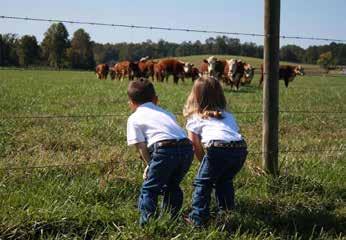
of the day, we’re a team and we win and lose together.”
This team mindset has been taught to Kade and Kendall since they were young. The family works together on the ranch, where the twins actively help their parents, learn the operation inside and out and make their own individual contributions.
Kendall is known for her outgoing, positive personality and love of the show barn.
“Kendall is the barn boss,” Max Stotz says. “Most families know who the barn boss is, and she runs the roost with show cattle. She’s detailed oriented and pays attention to the little things which is important if you want to succeed in the industry. You have to pay attention to the details.”
Kade is noted for his sense of humor, and always being the first one to jump in when they need to work with the cows or do tractor work.
“Kade is as sharp as they come,” Wade Perks says. “We were out looking at cows and he knows all the grass out in the pasture. He has a very mature sense of humor. He’s got a sophisticated wisecrack. I’ve seen him have conversations with my dad, who is 70, and my son who is 11.”
Despite all the time spent showing, and the numerous awards won, it is most important to Kendall and Kade that they do the right thing, no matter what.
“Both at the ranch and in our own operation, we strive to raise functional cattle that still have some style about them,” Kade says. “A lot of people say that they raise show heifers that can still go out into the real world and do what they are supposed to do. I like to think that I want to raise cattle that can go do things in the real world first, and then they can have style later. Without the cows in the pasture, we won’t ever have the showring.”
To anyone who knows Kendall and Kade, one thing is clear: they have a strong future in the industry.
“My parents have always pushed me to do different contests and step into leadership roles,” Kendall says. “Without them, I might not be the person that I am today, or had the success that I’ve had.”
Kade and Kendall have been leaders in a variety of ag organizations. Kade has held multiple leadership positions in FFA, currently serving as treasurer. He is a junior leader in 4-H and also enjoys leading Illinois Junior Hereford Association as president. Kendall is also a junior leader in 4-H, and serves as president of FFA. She also is secretary of the Illinois Junior Hereford Association where she and Kade dedicate a lot of time and effort running meetings, securing sponsorships, and putting on the show. Both Kade and Kendall are also involved in Illinois Junior Beef Association.
“Last year we got the opportunity to go to the Illinois Junior Beef Tour for the first time, which was a really cool experience to just explore some different career pathways or possibly spark interest for me,” Kendall explains.
The twins also enjoy mentoring younger members, helping them stay inspired to stay involved in the agriculture industry. They both participate in the Pen-to-Pen program through the National Junior Hereford Association. Older members mentor younger members, giving them advice and guidance. Plus, Kendall and Kade serve as good role models for the future generation.
“They have a true passion for the industry and the Hereford breed too,” Noah Benedict says. “I’ve got a little sister and she’s now set goals for herself. She’s a few years younger than Kade and Kendall and I tell her to look at them, and that’s what you have to do. Having those role models and people who are passionate about it means you’re going to be in good hands when they are leading the way.”
For Tom and Tammy, encouraging their children to be involved and be leaders in the industry has left them with rewards beyond winning championships.
“The best decision I made was to sign them up for peewee speech at the junior national,” Tammy says. “They are really confident getting up in front of groups. They are responsible and organized with schedules and what we have to get done. They manage school, work and their activities.”
Both Kade and Kendall plan to continue livestock judging at junior colleges. Kade plans to graduate high school early and spend the second half of his senior year traveling to shows and ranches, gaining work experience and making connections. His future career is undetermined, but he is confident he will work with Hereford cattle and the beef industry. Kendall plans to get her bachelor’s degree in an ag-related field. She is excited to explore her career options, knowing that she will always be involved in the beef industry and ag community.
No matter where they end up, it is clear Kendall and Kade Boatman will continue to have a positive impact on the beef industry.
“Watch out for these kids,” Noah adds. “You’re going to see them win a lot more awards like this. It’s lucky IBA got in early!”








A. Exhibitors must be over 8 and under 22 years of age as of January 1, 2024.
B. All animals must have health papers from a veterinarian.
C. All entries must be registered in the name of the exhibitor, who must show the heifer, unless other arrangements have been made with IJBA Jackpot Show staff.
D. This is an IJBA Points Sanctioned Show.
A. Registration papers are required.
B. Registered heifers will be shown by age, youngest to oldest.
C. Heifer and cow/calf classes will be offered for any breed that has at least five head. Registered females with less than five head per breed will show in AOB.
A. All entries will be made online through the ShoWorks platform at https://ijbajs.fairwire.com/ or through the link on the IBA website, www.illinoisbeef.com. Online entries are due Friday, August 2, 2024, at 11:59 p.m. at the rate of $25 for each heifer and/or cow-calf pair. Late virtual entries will be accepted until Tuesday, August 6, 2024 at 3:00 p.m. at the rate of $45 for each heifer and/or cow-calf pair.
B. All questions can be directed to the Devin Bollman by calling 217-787-4280 or by emailing devin@illinoisbeef.com.
C. All exhibitors must be IJBA members
D. Entry fees are non-refundable
A. All the non-Illinois State Fair cattle brought onto the fairgrounds for the Jackpot Show should be stalled in the Junior Livestock Building
B. All heifers and cow/calf pairs not showing at the ISF should arrive on the grounds some time during Saturday, August 10.
C. When your breed show is completed, you are released
A. All of the entry fees will be redistributed.
A. Posted in the Junior Livestock Building Saturday, August 10, by noon.
(zinc, copper, manganese, and selenium injection)


Multimin® 90 (zinc, copper, manganese, and selenium injection) is a one-of-akind solution to provide trace minerals. Research shows that supplementing trace minerals with Multimin 90 in a calf vaccination program tended to result in higher BVDV1 titers, resulting in 80% of calves reaching protective antibody levels versus 53% of the control group.

Visit axiota.com or scan the QR code for more information.
IMPORTANT SAFETY INFORMATION FOR MULTIMIN® 90: Not for use in humans, keep out of reach of children. Multimin 90 has a preslaughter withdrawal time of 14 days after injection. Do not use during the first trimester of pregnancy or in preruminant calves as safety has not been established. Selenium and copper are toxic if administered in excess and may lead to sudden death, depression, weakness, ataxia, salivation, and drooling. Do not use concurrently with other selenium or copper injections or boluses. Maximum volume per injection site is 7 mL. Allow a minimum of 30 days before considering repeat dosing. See prescribing information.
Active Ingredients: Zinc 60 mg/mL (as zinc oxide); Copper 15 mg/mL (as copper carbonate); Manganese 10 mg/mL (as manganese carbonate); Selenium 5 mg/mL (as sodium selenite)
Inactive Ingredients: Edetic acid 399.74 mg/mL; Sodium hydroxide 106.9 mg/mL; Benzyl alcohol 10.4 mg/mL (as preservative)
CAUTION: Federal law restricts this drug to use by or on the order of a licensed veterinarian.
INDICATIONS FOR USE
To provide a supplemental source of zinc, copper, manganese, and selenium in cattle. Not for use in pregnant cows and heifers during their first trimester because reproductive safety testing has not been done in these animals. Do not use in beef calves less than 2 months of age, dairy calves, and veal calves because safety has not been established.
Before using this drug, read package insert for full prescribing information.
DOSAGE AND ADMINISTRATION
Determine accurate body weights prior to treatment. Administer subcutaneously under the loose skin of the middle of the side of the neck per the following dosages depending on age and bodyweight of the cattle: Cattle up to 1 year, 1 mL/100 lb bodyweight Cattle from 1-2 years, 1 mL/150 lb bodyweight
Cattle over 2 years, 1 mL/200 lb bodyweight
To be administered as a single dose.
The maximum volume per injection site is 7 mL. Use standard aseptic procedures during administration to reduce the risk of injection site abscesses or lesions. Ensure there are at least 4 inches between injection sites for MULTIMIN® 90 (zinc, copper, manganese, and selenium injection) and other injection sites.
MULTIMIN® 90 is intended as a single dose product. Allow a minimum of 30 days before considering repeat dosing. Additional zinc, copper, manganese, or selenium products should not be administered at the same time.
Use within 28 days of first puncture of the vial and puncture a maximum of 15 times. If more than 15 punctures are anticipated, the use of multi-dosing equipment is recommended. When using a draw-off spike or needle with bore diameter larger than 16 gauge, discard any product remaining in the vial immediately after use.
CONTRAINDICATIONS
Do not use MULTIMIN® 90 concurrently with other injectable selenium and copper products.
Do not use MULTIMIN® 90 concurrently with selenium or copper boluses.
WARNINGS AND PRECAUTIONS
Withdrawal Periods
Cattle must not be slaughtered for human food consumption within 14 days of the last treatment. No milk discard time is required when used according to labeling.
User Safety Warnings
Not for use in humans. Keep out of reach of children. Do not allow children access to used or empty syringes. Wash hands after use. This product is highly concentrated in zinc, copper, manganese, and selenium. Due to a potential risk of zinc, copper, manganese, and selenium toxicity, care should be taken when handling the product to avoid accidental self-injection. Symptoms of exposure to zinc, copper, manganese, and selenium include aches, chills, nausea, vomiting, diarrhea, tachycardia, epigastric pain, tremors, and irritability.
In case of accidental self-injection or ingestion, SEEK IMMEDIATE MEDICAL ATTENTION and take the vial with you.
To report a suspected adverse drug experience or to obtain a safety data sheet, contact Multimin North America, Inc. at 970-372-2302.
ADVERSE REACTIONS
Accidental overdose of copper or selenium through misdosing or the use of multiple sources, including the use of injectable products in addition to high dietary levels, can result in adverse events, including death, depression, weakness, ataxia, salivation, and drooling.
Animal Safety Warnings and Precautions
Selenium and copper are toxic if administered in excess. MULTIMIN® 90 may cause clinical signs associated with copper toxicity or selenium toxicity, including death, if overdosed or used in conjunction with excessive dietary levels of copper and selenium or other selenium or copper products. Additional zinc, copper, manganese, or selenium products should not be administered at the same time. Do not use concurrently with other
injectable selenium and copper products. Do not use concurrently with selenium or copper boluses.
MULTIMIN® 90 may cause injection site swelling that appears on the day of injection and resolves by 2 days later. MULTIMIN® 90 may cause induration at the injection site that appears the day of injection and may persist for at least 14 days post-injection. These reactions may result in trim loss of edible tissue at slaughter.
Do not use in cases of known hypersensitivity to the active ingredients or to any of the excipients. Do not use in emaciated cattle with a body condition score of 1 on a 5-point scale in dairy or 1-3 on a 9-point scale in beef.
Do not use during the first trimester of pregnancy because safety has not been evaluated. Do not use in pre-ruminant calves because safety has not been evaluated.
TARGET ANIMAL SAFETY
Target animal safety was evaluated in cattle less than 10 months of age. Four non-pregnant females and four intact males received saline, 1x, 3x, or 5x the labeled dose for 3 consecutive days. The only treatmentassociated findings from the 1x dose group included injection site swelling and a minor, clinically insignificant, dose and time dependent decrease in cholesterol. The treatment-associated findings from the 3x dose group were injection site swelling, a decrease in feed consumption, and a decrease in cholesterol. In the 5x dose group, treatment-associated findings included injection site swelling, a decrease in feed consumption, a decrease in cholesterol, an increase in creatinine kinase, a decrease in calcium, and signs of acute copper toxicity (2 out of 8 animals), including sudden death, depression, weakness, ataxia, salivation, and drooling. Animals in the 5x dose group also had hepatic centrilobular necrosis on necropsy and an increase in serum chemistries associated with liver damage.
STORAGE, HANDLING, AND DISPOSAL
Store between 15ºC and 30ºC (59ºF and 86ºF)
Manufactured for: Multimin North America, Inc., Fort Collins, CO 80528
Approved by FDA under NADA # 141-582
FOI: https://animaldrugsatfda.fda.gov/adafda/app/search/public/document/ downloadFoi/15347
MULTIMIN® 90 is available in 100 mL and 500 mL vials.
Revision date: May 2024

busy summer of programs and events kicked off on May 29, with the second-annual Junior Beef Tour. Eleven passionate Illinois Junior Beef Association members had the unique opportunity to explore various careers within the beef industry over a two-day tour across West Central Illinois.
The tour kicked off at Western Illinois University where participants learned about their academic pathways with a small school setting, got unique hands-on experiences at the WIU beef farm and bull test center, and made personal connections with WIU faculty and staff.
Trevor Toland’s River Oak Ranch was the next stop on the agenda where juniors learned about rotational grazing and received a pasture tour through the paddocks at the ranch. Trevor detailed the importance, economics and steps for getting started with rotational grazing. He also reminded the juniors of the importance of being involved.
Dr. Carissa Gentry of Hancock Veterinary Clinic gave juniors a tour of her clinic, detailing animal health planning with topics such as BSE, vaccinations and pregnancy checking. She also listed various careers in veterinary medicine and laid out the educational pathways available for those looking to pursue veterinary medicine.
The final stop of day one was Dearwester Grain where Nick and Noah Dearwester gave a tour of the mill and chatted about automation in milling, biosecurity and precision. They also talked about careers in animal nutrition, being part of a family business and some employability skills and habits that are common among successful and driven individuals.
The second morning started with a visit to Fairview Salebarn where Jake and Laura Fidler gave a current cattle market overview, and stressed the importance of organizations like Livestock Marketing Association, IBA and NCBA. They then gave a salebarn tour, shared their sale schedule and rounded out with encouraging the juniors to create opportunities for themselves.
Lowderman Cattle Company was the next stop. Reid Suddeth and Rhett Lowderman gave a tour of their operation and talked about the components of successful seedstock operations. They stressed the importance of getting involved while still in school and searching early for employment opportunities. And last, but not least, they went into a conversation on Hereford genetics.
The finale was a career panel with Dr. Mark Hoge, Gayle Baker and Holly Spangler. The trio detailed topics such as evolving plans, striving for the next stage, productive habits and balancing school, a social life and work on your resume.
These two full days offered eleven high-quality Illinois Beef Juniors a first-hand look into the many career opportunities that exist right here in Illinois.

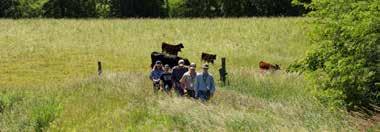
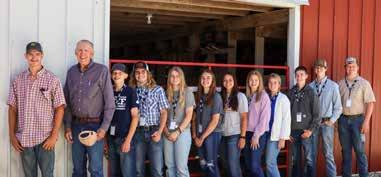
















Within the current consumer landscape, a complex interplay of consumer behavior and sustainability practices is evolving. It is a world where taste, ethics, and environmental consciousness intersect, influencing not just purchasing decisions but also production practices.
This evolution of consumer consciousness is playing out in a myriad of products and services and the beef industry is no exception. Through the data, we unravel the multifaceted tapestry of consumer preferences, environmental considerations, and the crucial role of trust in the beef industry.
Central to our exploration is the discernible shift in
consumer consciousness towards sustainability. In recent years, there has been a palpable surge in consumer demand for products that echo their environmental values. This is evident in the burgeoning popularity of sustainable alternatives, such as reusable bags, and the increasing preference for products boasting natural, eco-friendly ingredients.
Recent surveys reveal a significant portion of consumers actively engage in behaviors that support environmental causes. More than half of shoppers have already changed or are likely to change their shopping behavior due to environmental concerns. ¹ From reducing single-use plastics to opting for products with sustainable attributes, consumers are signaling a broader shift towards greener, more ecoconscious shopping habits.
This shift towards sustainability is not just a passing

Chart: Changes to Shopping Behavior Due to Environmental Concerns; Source: Kantar, ShopperScape Sightlines Deep Dive, Q1 – Q# 2023
fad; it is a fundamental reorientation of consumer values. As concerns about climate change and environmental degradation intensify, consumers are increasingly seeking out products that align with their ethical and environmental principles. The question for the beef industry is are these general consumer trends specifically impacting beef consumers, and if so, how can operators respond accordingly.
As consumers pivot towards sustainability, manufacturing practices and ingredient sourcing come under scrutiny. This heightened awareness of sustainability considerations underscores the growing demand for transparency and accountability within the beef industry. A 2022 Kearney study found that in the last five years, Google searches about the carbon footprint of beef have increased by 18%. ² Consumers want to know not just where their beef comes from but also how it is produced. This presents an opportunity for supply chain operators to embrace more sustainable practices, from sourcing strategies to packaging materials, and to communicate these efforts transparently to consumers.
Even though consumers have increasing awareness regarding beef sustainability, it does not mean that their sentiment is negative. Recent results from NCBA’s Consumer Beef Tracker, a contractor to the beef checkoff, reveal that relative to other proteins, beef ranks #1 as supporting causes important to consumers. ³ Further evidence shows that consumers consistently perceive production of beef to be the most environmentally friendly with meat alternatives in
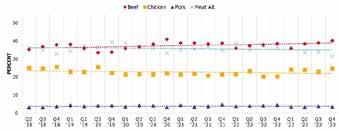
Chart: IS PRODUCED IN AN ENVIRONMENTALLY FRIENDLY WAY (% RANKED 1st); Source: Consumer Beef Tracker, 2018 – 2023. Q11: For the statement shown, please rate each protein based on your experiences. You can rate each protein anywhere from Agree Completely to Disagree Completely… The scale is set up so that no two proteins can have exactly the same rating, so you will need to place them in the order that you intend them to be. Analysis: National Cattlemen’s Beef Association, a contractor to The Beef Checkoff.
second place. ⁴ Moreover, beef’s lead over meat alternatives has been steadily increasing since 2019. ⁴
Trust is the bedrock upon which consumer confidence in the beef industry rests. Consumers increasingly want assurance that the beef they purchase is not only safe and nutritious but also produced responsibly and ethically. In fact, over 70% of consumers trust that beef is nutritious and safe to eat. ⁵ However, there are areas where operators can improve communications to help elevate trust within consumer perceptions about how cattle are raised. Looking at the same data set, consumers surveyed reported lower levels of trust when asked if cattle health is a priority and if cattle are given room to roam. ⁵

Chart: TRUST METRICS; HOW CATTLE ARE RAISED FOR FOOD (PART ONE); Source: Consumer Beef Tracker January – December 2023. CR4: “Thinking about how cattle are raised for food in the U.S., please tell us how much you trust each of the following statements.” Analysis: National Cattlemen’s Beef Association, a contractor to the Beef Checkoff.
Consumers tend to place an elevated level of trust in sources such as veterinarians, farmers, and government institutions. Amongst the consumers surveyed, veterinarians, farmers, and ranchers scored the highest at 62%, with organizations like the USDA-FDA and the CDC (Centers for Disease Control and Prevention) placing third and fourth at 57% and 53%, respectively. Anecdotally, large media outlets such as The New York Times and Fox News ranked last at 26%. ⁶
This emphasis on credible sources underscores the importance of transparency and reliability in building consumer trust within the industry. By fostering open communication and providing verifiable information about production practices, industry stakeholders can strengthen consumer trust and confidence in the beef supply chain.
Despite concerns about health and sustainability, there are several factors that rank higher in terms of why consumers choose to purchase beef over other proteins. Data from the Consumer Beef Tracker reveals that taste, convenience, and nutritional value continue to drive consumer preferences when it comes to beef products. A full 80% of consumers plan to maintain or eat more beef in the future. Of the 15% that plan to eat more, they cite reasons such as taste, adding protein to their diet, and the fact that beef is quick and easy to prepare. Unsurprisingly, of the 14% who plan to eat less, their reasons include higher prices, other meats are

Chart: FUTURE BEEF CONSUMPTION ; Source: Consumer Beef Tracker January – December 2023. Q3 Looking forward, do you plan to eat more, less, or about the same amount of each of the following? (Beef); Q13/Q14: “Earlier you mentioned that you plan to eat more/less beef. Which of the following statements are reasons why you plan to eat more/less beef in the future? (Select up to 5 statements) Analysis: National Cattlemen’s Beef Association, a contractor to the Beef Checkoff.
healthier, and health concerns. Interestingly, only 2.8% of that group cites ‘Eating Less Beef is Better for the Environment’ as a reason to eat less. ⁷ This simple fact illustrates that although sustainability concerns amongst consumers are growing, it remains a small motivator when it comes to beef consumption.
The data from the Consumer Beef Tracker provides valuable insights into the evolving landscape of consumer behavior and sustainability in the beef industry. As consumers increasingly prioritize sustainability and transparency, there is a need for supply chain operators to understand and share more about how beef is raised for food, and for the industry to stay committed to continually improving its environmental, economic and social responsibility.
1. Kantar, ShopperScape Sightlines Deep Dive, Q1 – Q# 2023
2. Consumer awareness of food’s environmental impact is slowly growing, Food Dive // Dawn of the Climavores, Kearney; April 2022
3. Consumer Beef Tracker, 2018 – 2023. Q11: For the statement shown, please rate each protein based on your experiences. You can rate each protein anywhere from Agree Completely to Disagree Completely… The scale is set up so that no two proteins can have exactly the same rating, so you will need to place them in the order that you intend them to be.
4. Consumer Beef Tracker, 2018 – 2023. Q11: For the statement shown, please rate each protein based on your experiences. You can rate each protein anywhere from Agree Completely to Disagree Completely… The scale is set up so that no two proteins can have exactly the same rating, so you will need to place them in the order that you intend them to be.
5. Consumer Beef Tracker January – December 2023. CR4: “Thinking about how cattle are raised for food in the U.S., please tell us how much you trust each of the following statements.”
6. Consumer Beef Tracker January – December 2023. SI3: Please tell us how credible you find each of the following sources of information regarding the US meat industries’ production practices. (Top 2 Box).
7. Consumer Beef Tracker January – December 2023. Q3 Looking forward, do you plan to eat more, less, or about the same amount of each of the following? (Beef); Q13/Q14: “Earlier you mentioned that you plan to eat more/less beef. Which of the following statements are reasons why you plan to eat more/less beef in the future? (Select up to 5 statements)


3-4 Lb. Arm Roast Salt, Pepper, Garlic. 1 Onion, sliced 1/2 Cup Beef Broth
12 oz. Pepperoncinis, with the liquid 1 packet of Italian seasoning
1. Smoke the roast
2. Add the ingredients, cover, and pull at internal temp of 200. Or, throw everything in a Crockpot if that is your preferential way of cooking! Sage City Market, owned by Sara and Wes Hornback, is located at 4 Sage Crossing Blvd, Monticello, IL, 61856.



State and National Beef Promotion and Research Programs Information is required by 7 CRF 1260.201 Failure to report can result in a fine. Information is held confidential per 7 CRF 1260.203.
Today’s Date ID Number (if known)________________________
Seller’s Name
Seller’s
Signature
Buyer’s Name
Buyer’s Signature
Both the seller & the buyer are responsible for making sure that the $1 per head assessment is collected and remitted to the Illinois Beef Association
Date of Sale
Total Number of Cattle Sold: X
*State of Origin
$1.00 per Head Federal Checkoff = Total Checkoff Payment for Federal and State
$0.50 per Head State Checkoff =
Person remitting form : Seller Buyer Phone Number:
*If the cattle purchased came from another state within the last 30 days, indicate from which state the cattle were purchased
Send Report and Remittance to:
The Illinois Beef Association (IBA) collects the Illinois Beef Checkoff in accordance with the Illinois Beef Market Development Act. IBA also collects the national beef checkoff fulfilling its role as the Qualified State Beef Council for Illinois as designated by the Cattlemen’s Beef Board. olivia@illinoisbeef.com
For additional information: call 217-787-4280 or email susan@illinoisbeef.com
Growing up on a farm in Jamaica, pitmaster Rasheed Philips learned from his father, who was a fisherman, how to repair nets, patch boats and cook over an open fire. Those early experiences planted seeds of inspiration, which are now flourishing. The flames sparked a desire in Philips to study simple techniques to prepare meat such as smoking and indirect cooking.
“I’ve been a pyro since I was a kid, but I learned to focus,” Philips chuckled.
A popular pitmaster as seen on Netflix’s hit series, American Barbecue Showdown, Philips works closely with NCBA, a contractor to the Beef Checkoff, sharing the taste, versatility and nutrition of beef with his followers through the Beef. It’s What’s For Dinner. brand. When asked about what draws Philips to beef as ingredient, his passion is evident, exclaiming “I love it!”
“Beef tastes so good and is so versatile. It is the only meat that has enough moisture to sustain high temperatures and still taste good,” he said.
Philips reminisces about family dinners as a child, enjoying ox tail prepared by his grandmother. He suggests that simple seasonings like salt or fresh herbs and spices are all beef needs to awaken taste buds.
In February 2024, Philips attended his first CattleCon in Orlando, Florida. His experience was enlightening, and he learned different aspects of the industry from multi-generational ranchers and small businesses to meat scientists and nutritionists.
plant a tree was 20 years ago, the second-best time is today.”
Ultimately, Philips is excited to be part of the beef family, sharing genuine stories and doing his part to deliver a positive beef message with the masses.
Philips wasn’t the only culinary dynamo to attend CattleCon24. The two new executive chefs for the Beef Checkoff-funded Culinary Center at NCBA traveled to the Sunshine State to experience their first cattle industry convention. While chefs Dagan Lynn and Paul Schutt have been to numerous food shows in their careers, CattleCon was an eye-opening experience for both of them.
“Wearing my chef coat at CattleCon was like my calling card,” said Lynn. “It helped to break the ice and was an invitation for people to come and talk.”
Although not new to cooking beef, Lynn and Schutt are newcomers to the cattle industry, and CattleCon provided an immersive experience into what it takes to raise cattle and produce beef for consumers. Cattlemen’s College and educational sessions offered the chefs a glimpse into the production side of the business, and Checkoff meetings were particularly beneficial.

“This is not just a business, but a way of life for producers,” he reflected. “I love not only learning about the industry’s history, but also how the next generation is changing for the future.”
Besides getting fitted for his first cowboy hat, Philips enjoyed his time speaking with producers from around the country, understanding their perceptions of chefs and learning how he can use his position and platforms to promote beef. Like many in the industry, Philips sees misinformation as a concern.
“It is amazing how misinformed the masses are,” he said. “I want to be that ‘cool uncle’ sharing accurate information about beef in a way that people will listen and understand.”
Philips is keenly focused on crafting educational programs for students to provide hands-on engaging curriculum about agriculture and proper nutrition. He knows the work done today will make a significant impact for generations to come. Philips finds this Chinese Proverb fitting: “The best time to
“Seeing the level of engagement by producers in Checkoff meetings was insightful,” said Schutt. “There is so much passion and information shared in those meetings, and producers truly demonstrated how invested they are in the industry.”
Both chefs commented on the level of care producers show in every aspect of their operations. Lynn was interested in learning about day-to-day challenges producers face, and how the Beef Checkoff helps drive demand for beef.
“Our cattle receive the best care, and our farmers and ranchers are providing them with the most comfortable lives,” said Lynn. “Their conviction of beliefs and values shine, and they are thoughtful, caring and giving people.”
Lynn and Schutt agree that beef is the most versatile protein available, and there is an exceptional story to share. The chefs are looking forward to collaborating with ranchers and understanding what they would like to see from the work in the Culinary Center. Whether it is discussing proper cooking techniques, developing new recipes or explaining different cuts, Lynn and Schutt are excited to promote beef’s benefits as well as be ambassadors for the industry.
“U.S. cattle producers care about their environment, the well-being of their animals, and putting nutritious food on families’ plates,” Schutt concluded. “It is our job to help share their passion by creating memorable eating experiences.”
Enjoy the flavorful combination of savory beef, tangy pickled onions, and creamy blue cheese in every bite! These burgers have a delightful twist that’s sure to impress your taste buds!
Ingredients:
5 pounds Ground Beef (80% lean, 20% fat)
Salt and pepper, to taste
10 slices American cheese
crumbled blue cheese
hamburger buns
Pickled Onions:
2 red onions, thinly sliced
1 cup apple cider vinegar
1 cup water
4 tablespoons granulated sugar
2 teaspoons salt

1. Preheat griddle flat top over medium-high heat until hot and evenly heated.
2. Divide the ground beef into equal portions, about 1/4 pound each. Roll each portion into a loose ball. Place onto hot griddle and flatten with a sturdy spatula or burger press to create a thin patty. Season with salt and pepper.
3. Cook patties until they develop a crust on the bottom, about 2-3 minutes. Flip patties and cook until a meat thermometer reaches 160°F, an additional 1-2 minutes on the other side. During the last minute of cooking, place a slice of American cheese on top of each patty to melt.
4. Toast the burger buns on the griddle flat top until lightly browned. Place a patty on the bottom halves of buns. Top patties with a generous amount of pickled onions and blue cheese crumbles. Close the burger with the top halves of buns.
Pickled Onions:
1. In a small saucepan, combine the apple cider vinegar, water, granulated sugar, and salt. Bring the mixture to a boil, stirring until the sugar and salt dissolve.

2. Add the thinly sliced red onions to the boiling liquid; turn off the heat. Let the onions stand in pickling mixture 15-20 minutes. The longer they sit, the tangier and more flavorful they become.





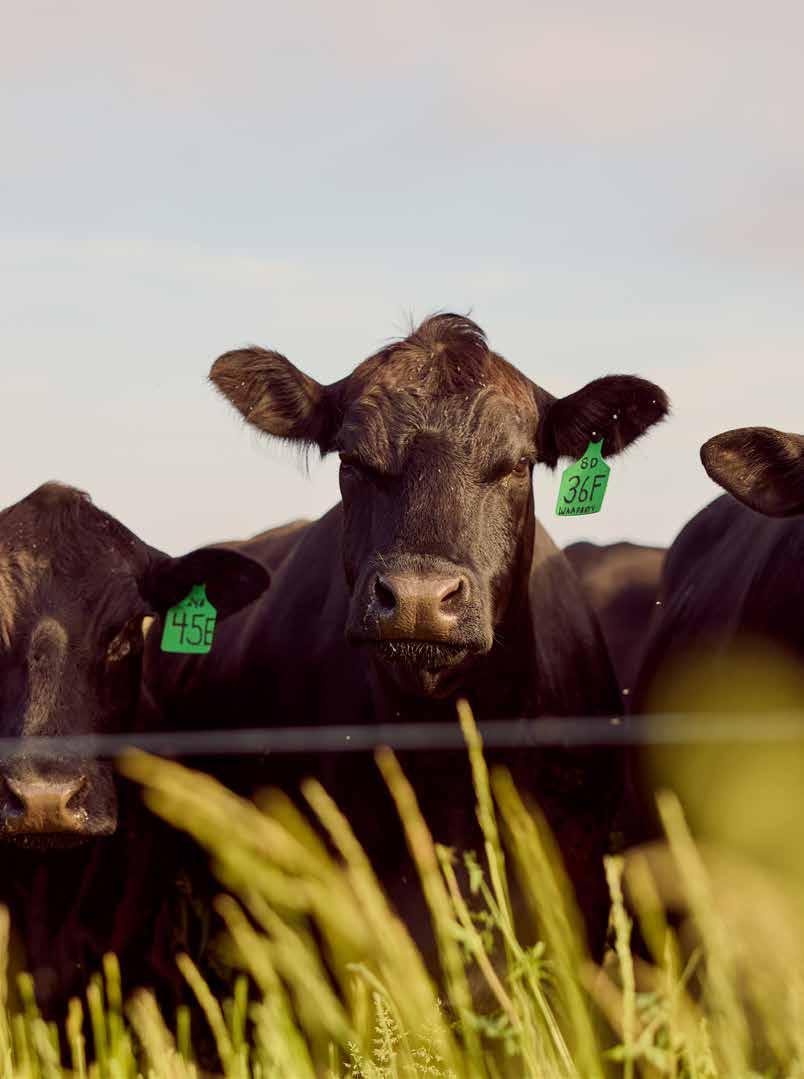


President: Carla Jurgenson
Vice President: David Mool
Secretary: Clay Sellmeyer
Business Manager: Doug Turner
Past President: David Jenkins
Bureau County: Vaughn Kiner
Central Illinois: Luke Lemenager
Logan County : Carla Jurgenson
Northern Illinois: Jarad Carroll
South Central: Richard Hurst
Wabash Valley: Shaye Harre
Directors at Large:
Sam Brumlevy
Brent Hinkle
TJ Curtin
Brian Hutchins
Kyle Buetke
Jeff Dameron
Chris Cassady
Clay Sellmeyer
Dan Naughton
Eric McClure
David Mool
Bodee Schlipf
Brad Evans
Tracy Rawlings
To place advertisements or your latest Angus news contact: Olivia Hoots Illinois Beef Editor Illinois Beef Association 217-787-4280 olivia@illinoisbeef.com www.illinoisbeef.com
Photo taken by Devin Bollman at 2024 IBA Environmental Stewards of the Year Wes and Martha Green’s Diamond G Farms.
AngusLink’s Genetic Merit Scorecard (GMS) adds a fourth score option, Maternal, to demonstrate the maternal weaned calf value to aid in the selection of replacement females.
As the cattle industry prepares for herd rebuilding, a new tool for objectively describing the genetic potential of replacement females hits the market and with it an opportunity for producers selling replacement females to market their added genetic value. The AngusLinkSM Genetic Merit ScorecardSM (GMS) draws on the industry’s largest database to evaluate the genetic merit of a pen of feeder cattle, and starting in June, its new Maternal Score demonstrates an enrollment group’s maternal weaned calf value to aid in the selection of replacement females.
“The Maternal Score is becoming available at a perfect time with herd expansion on the horizon,” said Troy Marshall, director of commercial industry relations with the American Angus Association®. “Maternal traits are generally more difficult to quantify because of the need to match cows to their environment, so it’s going to be a valuable tool for producers marketing or purchasing replacement females.”
The Maternal Score will be displayed alongside other scores – Beef, Feedlot and Grid – on the GMS as females are marketed.
Marshall continued, “This new tool provides a reliable way to compare cattle’s performance potential across our industry and rebuild with better genetics that are more closely aligned with targets that the marketplace has clearly defined: increase in efficiency and increase in the consumers’ eating satisfaction, primarily through increased marbling and quality grade.”
John Dickinson of Parnell Dickinson Inc., Auburn, California, is one of the Association’s board members.
“I see the same evolution coming with the Maternal Score that we have witnessed the past few years with Beef, Feedlot, and Grid scores already on the GMS,” Dickinson said. “In today’s marketing landscape, reputation and historical data are still very important, but buyers also want more tools they can use to mitigate risk.”
Information about individual component traits, specifically for mature size and milk production, will also be shared alongside an enrollment group’s Maternal Score; so, producers can better understand how a group of cattle would match with their environmental conditions. Dickinson said this appeals to both buyers and sellers because they can dive into individual maternal components.

“This is really exciting as the GMS Maternal Score is not only the first predictor of its kind in the industry, but also can you think of a better time for this tool to become available than when we have the smallest inventory numbers in over 50 years?” Dickinson said. “We will see a re-build and retention soon, and the Maternal Score can play a large role in moving you to the front of the market.”
To enroll, a producer must be AngusVerifiedSM through IMI Global, providing a list of sire registration numbers. Unique to the Maternal Score, the cattle must also have a predominantly Angus cow base.
There is no additional cost associated with the GMS program or AngusVerifiedSM, aside from IMI Global’s Age and Source verification enrollment, which includes an EID tag.
“There’s a lot of science behind this scorecard,” said Rafael Medeiros, geneticist with Angus Genetics Inc. (AGI®).
Scores are determined by the average EPDs of the bulls used to sire the current enrollment group and the cow herd’s genetic makeup. To raise cattle’s Maternal Score, a producer would want to select for higher Maternal Weaned Calf Value ($M) on registered Angus sires.
Medeiros, who led the technical development of the new score, said this prediction tool uses similar rationale to other genetic prediction tools managed by AGI®, and is supported by Angus sire data and data from the USDA’s U.S. Meat Animal Research Center breed averages.
“If you’re not genotyping, this is the best estimate and the best value,” he said.
Medeiros added it is important to know that like the other GMS values, the Maternal Score characterizes the enrolled group, not individual animals. In this way, the program can also serve as an instrument to track a herd’s genetic progress to make sure the next calf crop is better than the last.
As a seedstock producer, Dickinson said he sees the Maternal Score as another profit-minded program he and other members of the Association can offer their customers.
“This is yet another service we are providing for our commercial customers and those continuing to pay a premium for registered Angus bulls,” he said. “We are committed to their success and profitability being a pathway to our own. When they
build back, we want them to build back with Angus – not necessarily because of reputation or nostalgia, but because we can provide them with the highest quality and most accurate tools for production and management in the industry today.”
For more information or to enroll cattle, call 816-383-5100, or contact AngusLinkSM via email at anguslink@angus.org. IMI Global can also be reached to help start an enrollment at 303-895-3002, or producers can complete its contact form at www.imiglobal.com/contact.
– Written by Sarah Kocher, Angus Communications
Timonium, Md. | May 25 | Judge: Travis Pembrook, Okla.
Photos by Next Level Images


Reserve Grand Champion Bred and Owned Female
PVF Blackbird 3152
Owned by Adam Miller

Calf Champion
Dameron C-5 Nellie 2145
Owned by Quentin Day

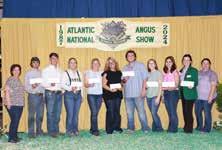
Calf Champion
PVF Missie 3185
Owned by Ashtin Dillow
Timonium, Md. | May 26 | Judge: Andy Higgins, Auburntown, Tenn.
Photos by Next Level Images
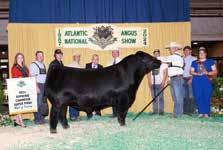


Reserve Grand Champion Cow-calf Pair
Diamond T Saras Dream 0206
Owned by Morgan Hutchins

Reserve Grand Champion Female
PVF SFA Missie 3067
Owned by Ashtin Dillow

Senior Heifer Calf Champion
Dameron C-5 Nellie 2145
Owned by Quentin Day
Bloomington, Ill. | May 30-June 1 | Judge: Brock May, Wis.
Photos by Cindy’s Livestock Photos

Central Illinois Grand Champion Heifer
DDA Northern Miss 2318
Owned by Max Dameron

Central Illinois 3rd Overall Heifer
CK3 Barbara K69
Owned by Cylee Kirchner
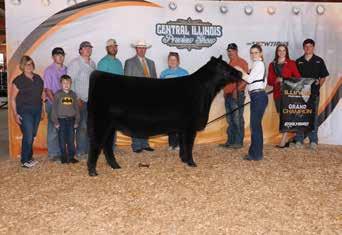
Central Illinois Reserve Grand Champion Heifer Lemenager Proven Queen L14
Owned by Paige Lemenager

Central Illinois 4th Overall Heifer
HTF lady 2317
Owned by Brode Bergman

Central Illinois 5th Overall Heifer
PVF SFA Missie 3071
Owned by Ashton Dillow













Res. Champ. Owned Female
DDA Northern Miss 2318
Owned Max Dameron

3rd Overall Owned Female PVF Missie 3184
Owned by Chloe Boitnott

Champion B & O Cow-calf
DDA Northern Miss 2211
Owned by Reese Anderson

Champion Cora Craig Res. Champion Berklee Bedel

4th Overall Owned Female FCF WHM Phyllis 258
Owned by Anna Johnson

5th Overall Owned Female SULL Ellie 2571K
Owned by Christian Fischer

Reserve Champion Cow-calf Dameron C-5 Lucy 2242 Owned by Anne Dameron




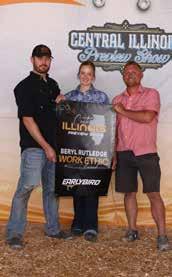



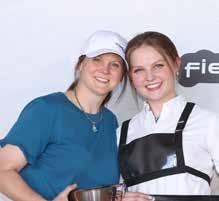
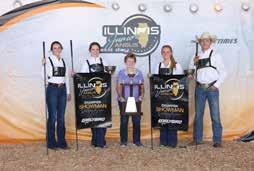
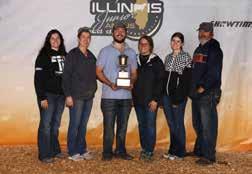

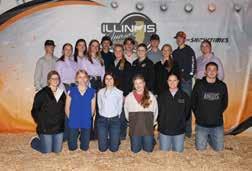



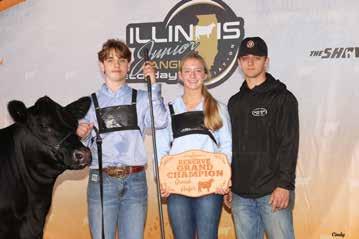

Mark your calendars for March 8!
Northfield Inn & Suites • Springfield

2025 BANQUET 2025 BANQUET
More information coming soon!






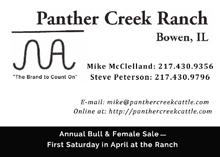
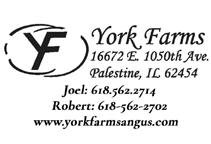







PRESIDENT
Kent Burns
618-521-3199
TREASURER
Buddy Edenburn 217-649-0108
MEMBERSHIP SERVICES
Emily Bernard 815-992-8233
illinoishereford@gmail.com
BOARD OF DIRECTORS
Cody Crum, 217-248-7282
Jodi McMillan, 815-751-2293
Chad Benedict, 217-246-5099
Matt Anderson, 309-267-1410
David Biggs, 815-441-4354
Kim Carney-Rhodes, 217-899-4104
Jimmy Bernard
Craig Crutcher
Andrew Spinazola

In Southern Illinois, we are finally as dry today as we have been since March. As I write this, we still have 40 percent of our beans to plant and we finally rolled our first hay up yesterday, June 12. This has been a very challenging spring for our immediate area. Everyone continues to plant soybeans and there are several acres of corn that farmers elected to take prevent planting. Did I mention the wheat is ready to be harvested as well? The good news is the weather forecast seems to finally be in our favor to get some farming finished up.
The bright spot of this spring has definitely been the cattle market. The spring sale season was outstanding. The demand for all cattle has been great, but the demand for Hereford bulls has been record setting. In fact, in our neck of the woods it is nearly impossible to find a twoyear-old bull to sell for this breeding season. It appears that high cattle prices will continue for a while longer. Illinois Hereford Association membership, I encourage you to capitalize on this market. Plan your approach for the next year to maximize your profit and keep promoting the Hereford breed!
As summer begins, so does the summer show season. I would like to wish all Illinois Hereford Juniors the best of luck and safe travels as they head to Georgetown, Illinois, this weekend for the Illinois preview show and then as they travel to Grand Island, Nebraska, to compete at the junior national and the various state fairs in the Midwest. I am looking forward to seeing what our youth can accomplish with their summers!

-Kevin Babbs
What a stellar summer it has been to this point for the Upper Midwest Territory of the AHA. My travels thus far have shown me superb spring calf crops that represent some of the top sires in the breed, and breeders are displaying tremendous enthusiasm for the future of their operations. Even more, the state preview shows have been stacked with quality cattle from top to bottom. Illinois breeders descended upon Georgetown on Father’s Day weekend with a top-notch lineup of cattle that warranted lots of deliberation from the judges. Congratulations to all the exhibitors for a successful weekend, and best of luck as the show season progresses to Grand Island, state fair, and the fall show circuit.
As we look forward to the calendar post September 1, the region will be full of opportunities for commerce. A mixture of live and online sales alike are stacked in the calendar of events for the fall season. For a complete list, please reference the July issue of Hereford World. These offerings are sure to represent some of the best genetics Hereford breeders can acquire; if I can be of assistance in helping you purchase cattle this fall, please feel free to reach out. We at HPI are excited to help folks continue to market their product. Our extensive list of services can be catered to fit every situation. Whether it be catalog design/ production, postcard mailers, Hereford World ads, digital marketing, or anything else, we are ready to assist you with those needs. Additionally, we have a select few spots available for the Illinois breeder pages featured in the Hereford World; if you would like more information about those available opportunities or would like to advertise, please feel free to contact me.

Corbin Cowles, American Hereford Association
Territory 5 Field Staff
To conclude, it is no secret the weather has been challenging recently for people across the country. Excessive rainfalls halted plans for planting crops and hay cuttings, putting farmers significantly behind the eight ball. Now, the heat is starting to rear its head and make it difficult on livestock (and humans alike). Yet, even when Mother Nature makes life difficult, we are reminded by the Good Book that we serve the God of plentiful harvest who is faithful and just to provide. As Psalm 85:12 says, “Yes, the LORD will give what is good; And our land will yield its increase.” My prayer is that the weather will stay in each of your favor and our faith stays strong that God will faithfully keep His promises.
Best,
Illinois Hereford Association,
IHA Winter Classic Sale Part Two! A huge congratulations to those that consigned and made the Inaugural IHA Winter Classic Sale a success, and let’s look forward to making it even better for 2024.
The IHA Board has prioritized adding value for the Illinois Hereford Association membership. This second-annual event, is a way for all members to market the best of their herds , and connect with breeders and commercial cattleman from all over the state.
The Illinois Hereford Association Winter Classic Sale will be held on December 14th, 2024 in Carthage, IL at Carthage Livestock Inc. Brent and Kris Lowderman were incredible hosts last year, and we are excited for the chance to work with them again this year. They have and will continue to do incredible work for the Hereford breed, making this the perfect spot to continue to build this sale. Once again, Cody Lowderman will be serving as the auctioneer for this event.
I will be handling the screening process again for the IHA this year. The IHA board and I want to ensure quality stays consistent to help everyone turn as much profit as possible. All the nomination forms for the sale will be due on August 1st. Shortly after the first, I will begin planning to travel to farms with said nominations to screen the cattle.
When selecting cattle to nominate, I highly encourage you to select cattle that represent the best your program has to offer. The IHA Board sees the Winter Classic Sale as an annual event for breeders to purchase elite Hereford seedstock. To make this sale a household name, we must improve upon the already impressive set we had last year. Cattle with phenotypic quality, popular pedigrees, and desirable genomic profiles will add value and make this sale a success. The board and I will be placing a big focus on selling quality bred heifers and fall cow-calf pairs.
In the rest of this document, you will find the calendar of events, the general rules and requirements for the sale, and the nomination form. If there are any questions, please do not hesitate to reach out.
The IHA Board and I are both looking forward building this sale for year two. We would love to work with any members of the IHA on consigning to this sale.
Sincerely,
The Illinois Hereford Association Winter Classic Sale is a screened sale. All cattle must first be nominated by the August 1st, 2024 deadline. All nominations must be accompanied by a non-refundable $50 per-lot nomination fee. If cattle are accepted after screening and consigned to the sale, this $50 fee will be credited to the consignor’s sale expenses. No cattle will be accepted that have not gone through the nomination and screening process. Any member of the Illinois Hereford Association that has paid their dues in 2024 and been accepted after nomination and screening is allowed to consign to this sale.
Other requirements:
1) Membership dues for the Illinois Hereford Association for 2024 must be paid by the time of nomination.
2) No animal will be accepted without actual (individual) EPD’s available by the time of cataloging. If EPD’s are not available at cataloging time, the animal will be rejected and no refund of fees will be made.
3) Any known carrier of any genetic defect will not be allowed to sell.
4) Cattle must be registered prior to cataloging, or they will not be accepted.
5) There shall be no substitutions after cataloging and there will be no refund of nomination or entry fees if an animal is not brought to the Winter Classic Sale. Substitutions may be made only prior to cataloging with screener approval.
6) Age of cattle:
a. All bulls must be at least 12 months of age, and no older than 30 Months of age
b. All females in sale must be under 5 years of age with calf at side or confirmed bred
c. Open females will be allowed in the sale, but in a limited amount
7) Bull Requirements
a. Must have passed a Breeding Sound Exam (BSE) within 30 days of the sale
b. Must have Genomically Enhanced EPD’s (GE-EPDS) and DNA on profile with the AHA
8) Female Requirements
a. Females being sold as bred to be confirmed on health papers within 30 days of sale
• Females due to calve between the sale and 2/15/25, have the option to provide a health paper within 60 days of sale to confirm pregnancy, alongside their standard health-paper within 30 days of sale
b. Females must be bred to have their first calf by 30 months of age
c. RECOMMENDED that females are ultrasounded to determine sex of the pregnancy
d. RECOMMENDED that females have GE-EPDS and a DNA on profile with the AHA
9) Health –
a. All cattle are required to have separate, official interstate health papers at sale time. Do not place multiple animals on one form.
b. All cattle must have a RFID or metal tag per state regulations. Suggested tests are Bangs, Anaplasmosis, Tuberculosis, and BVD. If your animal(s) sell into a state requiring listed tests, breeders will take the subject animal to its origin, have it tested, and once cleared, arrange shipping to the buyer.
10) Substitutions can be made up until the catalog deadline. They must be approved by the screener before said deadline.
11) Withdrawals made after cataloging are responsible for average sale expense of lot type.
August 1st
All nominations must be either post marked or emailed along with the $50 per lot nomination fee. Nomination fees are non-refundable but will be figured into sale expense if the animal is accepted.
August 1st - October 1st
I will be making screening arrangements to be made.
October 15th
All information for catalog is due. Footnotes, pictures, breeding information, etc. Substitutions cannot be made after this date.
December 13th – 3 pm
All Cattle in place at Carthage Livestock Inc.
December 13th – 6 pm
Illinois Hereford Association Social
December 14th – 11:30 am
Illinois Hereford Association Winter Classic Sal
When selecting your animals to nominate, please keep in mind the rules and recommendations listed above in the document. All bulls to sell must have their DNA profile completed, and all females 30 months of age or older must be bred or have a calf at side. All cattle must be registered and have EPD’s by the time the catalogue is produced. Also, remember that your 2023 dues to the IHA must be up to date. Please Contact Buddy Edenburn or Noah Benedict for this.
Make checks payable to the Illinois Hereford Association. The fee is $50 per lot nominated. This is non-refundable but will be figured into sale expense if your nomination is accepted. Mail checks to Noah Benedict – 605 CR 2300 N – Dewey, IL 61840
Farm Name:
Mailing Address:
Farm Address (where screening will happen) :
Phone Number:
Email:

JUNE 14-16,2024 |
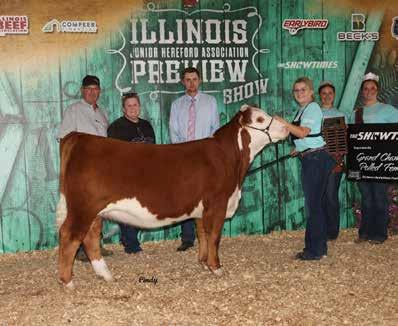
KJ 746D COCO CARMEL 321L ET PAIGE LEMENAGER

3RD OVERALL POLLED FEMALE
HAWK PARKER 2302 ET ELLA BROOKS
RESERVE CHAMPION POLLED FEMALE
PRCC FAITH’S KATIE 303L ET FAITH BENEDICT

5TH OVERALL POLLED FEMALE

4TH OVERALL POLLED FEMALE




KJ TWJ 907E MARTINI 936K ET PAIGE LEMENAGER
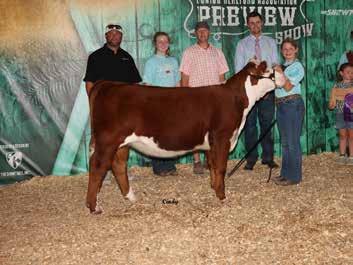
3RD OVERALL HORNED FEMALE
STOL 711 28 MANEATER 0623 TENLEY STOLLARD
5TH OVERALL HORNED FEMALE
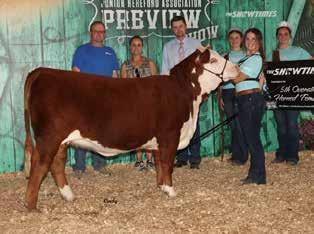
PURPLE HB ISLA 90L ELAINA WALSH

RESERVE CHAMPION HORNED FEMALE
CW CC MERLOT 361 ET LAUREN JONES

4TH OVERALL HORNED FEMALE
PRCC LSC LUCY 301L ET HATTIE YOUNG

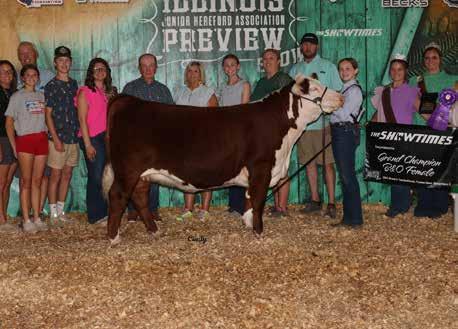






CRANE THE BOSS 233
ELLA CRANE

HPH 756 LADY LUCK 5480J
NICK JONES
CHAMPION STEER

DF ACD DARRELL 301
MAKENZIE HULS


BANE SIR MIXALOT 234
ELLA BANE
RESERVE CHAMPION COW/CALF PAIR

PERKS CATO 5049 CADY 1124
RHETT LEHMAN
RESERVE CHAMPION STEER

CRANE ANCHORMAN 2327


CHAMPION: LAUREN JONES
RESERVE CHAMPION: KENDALL BOATMAN

CHAMPION: RESERVE CHAMPION: ELLA BANE KADE BOATMAN
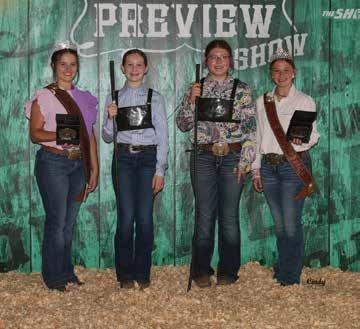
CHAMPION: ELLA CRANE
RESERVE CHAMPION: ADDISON YOUNG

CHAMPION: CORBIN SWIGART
RESERVE CHAMPION: NASH LOWDERMAN





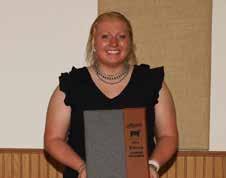
RETIRING MEMBER:
Emma Richardson. Not Pictured-Corey Stumpf and Morgan Jones.

2023 ROYALTY:
Queen-Allie Anderson
Princess-Paige McCaskill
Princess-Shelby Pearl

JNHE HEREFORD BOWL TEAM:
Junior Team: Addison Duis, Cora Chapman, Ella Crane, Owen Crutcher. Alternate-Peyton Garnhart. Senior Team: Kade Boatman, Kendall Boatman, Brogan Keltner, Morgan Richardson. Alternate-Dellana Muck

FITTING CONTEST:
Senior Fitting:
Champion-Simon Shepard Reserve-Karson Sundberg
Junior Fitting: Champion-Peyton Sidles Reserve-Addison Young
Pee Wee Fitting Champion-Hattie Young

SALES AND SPEECH:
Illustrated Speech: Owen Crutcher
Corbin Perry
Advanced Speech: Caden Perry
Individual Sales: Addison Young

HARRY & GEORGE TJARDES MEMORIAL SCHOLARSHIP
Morgan Richardson

WAYNE SAGE MEMORIAL SCHOLARSHIP
Morgan Richardson

2024 IJHA OUTSTANDING MEMBER
Morgan Richardson
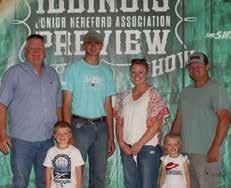
CHRIS STEPHENS MEMORIAL SCHOLARSHIP: Connor Rhodes


BACK ROW: Brogan Keltner, Griffin Anderson, Cora Chapman, Lillie Anderson, Corbin Perry, Addison Young. FRONT ROW: Owen Crutcher, Crayton Chapman, Maggie Shepard, Hattie Anderson, Gabe Crutcher and Not Pictured Ty Anderson

FACES OF LEADERSHIP TRAVEL SCHOLARSHIP WINNERS:
BACK ROW: Shawn Crutcher, Caden Perry, Nolan Lee, Faith Benedict, Kade Boatman. FRONT ROW: Aidan Knobloch, Trevor Crutcher, Hatten Brother (representing Clayton & Denton Stapleton), Ellie Lehman, Kendall Boatman.

2024-2025 IJHA BOARD OF DIRECTORS
BACK ROW: Connor Rhoads, Ella Bane, Emma Richardson, Morgan Richardson (Vice President), Kendall Boatman (Secretary), Paige Lemenager (Director of Public Relations), Nolan Lee. FRONT ROW: Aidan Knobloch, Shawn Crutcher (Treasurer), Kade Boatman (President), Rhett Lehman.

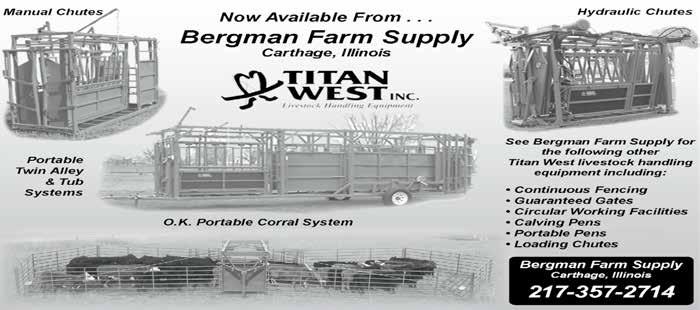








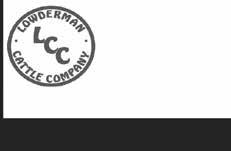





Illinois Charolais Association O cers
President: SharleneBullard- 815-343-9381
Vice President: Marla Todd- 217-840-5949
Secretary/Treasurer: Robb Creasey- 309-255-7799
Members:
LaFraise Farms, Flanagan
Dale - ehcstreB 5-67 4-4419 5932-476-518Steve - ehcstreB
Bertsche Farms, Flanagan Troy Bertsche- 815-67 4-1244
Bewely Farms, Yates City Beau Bewely - 309-358-143 4 / 309-208-0786
Bullard Cattle Co., Cornell Paul Bullard- 815-343-9380 Sharlene Bullard- 815-343-9381
Creasey Charolais, Macomb Robb Creasey- 309-255-7799
D-Mar-Mac Charolais, Warsaw Sam Zumwalt- 217-256-4619
Tom Engel, Flanagan815-674-5140
Grusy Bros., Gridley Frank Grusy- 309-747-2696
K&D Cattle, Elizabeth Kelley- 815-275-8904 Devin- 815-858-2318
Nord Farms, Bloomington Ron Nord - 309-275-0409

Barnard Farms, Foosland Matt Barnard217-417-7699
Michael Potthast, New Douglas217-456-1266
Joseph Potthast, Sorento - 217-456-1266
Christine Potthast, New Douglas217-456-1266
Roger Elliot, Greenview - 217-416-8981
Marla Todd, Foosland - 217-840-5949
Steve Hoag, Illinois City - 563-506-0544
Link Livestock, Rio 309-297-0293




ast weekend was the Illinois Junior Simmental Association Preview Show in Jacksonville. In the following pages, you can see the junior members and their achievements in the showring from the weekend. We celebrate their successes and the work and investment that makes that happen, but on my drive home from the weekend, I could not help but think about the people that make these opportunities happen for our youth.
We are appreciative of Cody and Gary Hadden who were our hosts with the most in making sure that everything ran smoothly at the Morgan County Fairgrounds. We are thankful for their hospitality and gracious assistance in making sure we had what was needed to pull off a successful show.

Our junior board of directors for the Illinois Junior Simmental Association is second to none – they take their roles seriously and put the work in to make sure that things get done. They are directed by Junior Advisors Emily Adcock, Julie Knodle and Robyn Hendel, and we are all grateful for their dedication to our kids. They are behind all the friendly touches like coordinating the potluck dinner for Saturday evening, and taking care of all the details that go largely unnoticed by everyone who shows up to the event that “just happens” to run smoothly as a result. Lacey Schick shows potential as a future game show host as she coordinated our educational activity and coordinated a quiz bowl competition to help prepare kids for the quizzes that are part of the Regional and National Classics to help prepare them for that event.
As you scan the barns and grounds, you see the unnamed parents, grandparents and other friends and family helping their kids, helping them learn how to do things when they are young, and being told what they are doing wrong when the kids get older. Your influence matters and you are doing the most important step of their development, just getting them to these types of activities where they can learn and grow from their new friends and peers.
As you continue through the summer, be it your local county fair, or a Junior National event, take a minute to look around and appreciate the people behind the event and what they are doing to make it happen. Without knowing who these people are in your particular circle, I expect they share a common theme – they want to see great opportunities happen for the kids, and they probably appreciate that someone did it for them when they were younger. Seek opportunities to say a simple thank you to these folks and let them know that you see them.

Best wishes for a safe and enjoyable summer!
Joe Webel, ISA
President
(217) 621-7362 | joe.webel@gmail.com
2024 Preview Show - Heifers
Jacksonville, Ill. | June 9
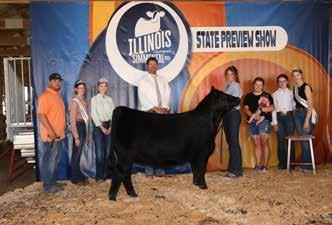
Grand Champion Purebred Heifer
JSUL Wise 340L

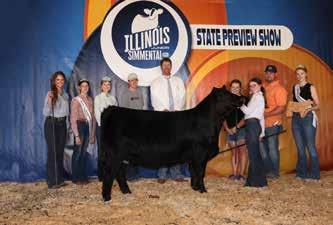
Reserve Champion Purebred Heifer



Grand Champion Bred & Owned Heifer

BAILEYS

Reserve Champion Bred & Owned Heifer

Champion Early Spring Yearling
WINSLOWS Future L97 ET
Jacksonville, Ill. | June 9
by Cindy’s Livestock Photography

Grand Champion % Heifer
UDE Princess 172L


Reserve Champion % Heifer
JSUL Who Dat 3392L



Grand Champion Bred & Owned % Heifer
DF Talk About Tulsa
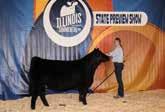
Reserve Champion
Summer Yearling
TBC2 Classy Lady L706
Curtis Lemenager
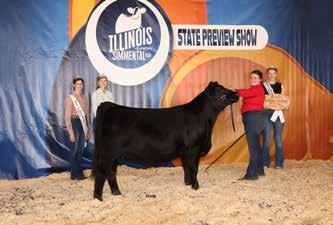
Reserve Champion Bred & Owned % Heifer

2024 Preview Show - Steers/Bulls
Jacksonville, Ill. | June 9
Cindy’s Livestock



DBLG Double Take L207

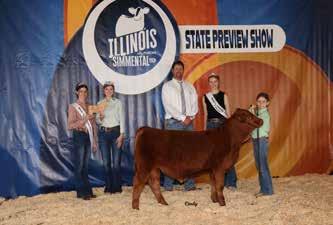

Jacksonville, Ill. | June 9
Photos by Cindy’s Livestock Photography

Grand Champion Purebred Cow-calf
JSUL Riverboat Queen K227
Grace Lemenager

PeeWee Showman
Stetson Beckman

Junior Showmanship Champion: Jemma Dorsey Reserve Champion: Macy Beckman

Grand Champion % Cow-calf
BRAMLETS Dakota K201
Ava Gilbert

Intermediate Showmanship Champion: Mabrey Schick Reserve Champion: Mylee Moore

Senior Showmanship Champion: Josie Webel Reserve Champion: Abagayle Britton

Clinton, Ill. | June 1-2
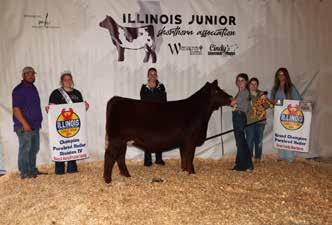
Grand Champion Purebred Heifer, Div. 4
FSF Red Beauty
Jemma Dorsey

Grand Champion Bred & Owned Purebred
Heifer, Div. 4
Wernacres Rosebud 234
Laci Wernicke

Champion Division 1
TRN Rosie’s Knight 405 ET
Josie Turner

Reserve Champion Div. 1
TNR Dreaming Ruby 402 ET
Alexa Turner


Reserve Champion Purebred Heifer, Res. Div. 4
Little Cedar Hopes Mirage 2321 ET
Kinlynn Dryer

Reserve Champion Bred & Owned Purebred
Heifer, Res. Div. 5
QK Continental Jewel 2301
Alyssa Miller

Champion Division 2
CF Mona Lisa 3134 PW X ET

Champion Division 3
NF Rosa Is Back ET
Lauren Mohr
Reserve Champion Division 3
LWFS Mona Lisa UH 2321
Maddox Reedy
Clinton, Ill. | June 1-2

Grand Champion Shorthorn Plus Heifer, Div.
3, Grand Champion Bred & Owned Heifer
Dry Miss Blossom L25 PR
Wyatt Dryer

Reserve Grand Champion Plus Bred & Owned
Heifer, Div. 3
MFSF Panda
Lauren Mohr

Champion Division 2
Devyns Margarita Mixer 1203
Avery Barnes-Underwood

Reserve Champion Div. 4
CCS DLJ Myrtle BO 402L ET


Reserve Champion Shorthorn Plus Heifer, Div. 4
FOX Kesha Kate 31L
Maddox Reedy

Champion Shorthorn Plus Cow-calf
T2 Maybelle Starr
Toby Behrends
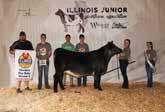
Champion Division 5
MFS Blue Bebe 22L

Reserve Champion Div. 5
Clinton, Ill. | June 1-2

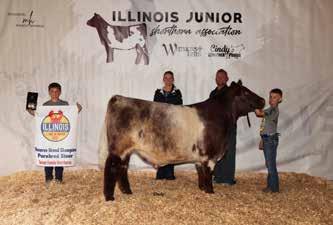




Clinton, Ill. | June 1-2
Photos by Cindy’s Livestock Photography

Grand Champion Bred & Owned Bull
IP IFS TM Hephaestus S-4L Troy Miller

Prospector 1
Showmanship
Champion: Josie Turner
Reserve Champion: Caleb Smithers

Prospector 2
Showmanship
Champion: Maddox Reedy
Reserve Champion: Jemma Dorsey
Junior Board


Ella James, Show Chair; Toby Behrends, Treasurer; Grace Rincker, President; Alyssa Miller, Secretary/Public Relations; Callie Turner, Director; Tate Behrends & Grace Brown, Co Vice President w/ Tate Behrends(not pictured; Also not pictured: Isabella Bunting, Director; Kessler Collins, Director; Reagan Reedy, Director

Intermediate Showmanship
Champion: Callie Turner
Reserve Champion: Toby Behrends

Senior Showmanship
Champion: Alyssa Miller Reserve Champion: Grace Brown






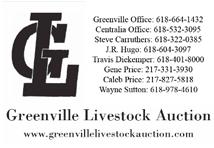


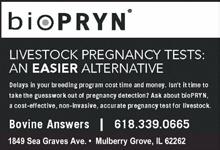




















MARK JOHNSON — NORTHERN ILLINOIS CELL: 815-274-6096
MKJOHNSON@LANDOLAKES.COM
MEGAN MYERSCOUGH — CENTRAL ILLINOIS CELL: 217-722-0787
MMYERSCOUGH@LANDOLAKES.COM
DAVID WILLIAMS — SOUTHERN ILLINOIS CELL: 618-713-7525
DWILLIAMS@LANDOLAKES.COM







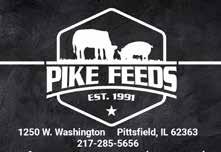






Illinois Beef, printed bi-monthly, is the official publication of the IBA. It serves as the voice of Illinois’ 12,000 beef producers.







